| Adirondack Southern | 33 x 38 | This multi-level layout is based on a similarly named plan by Iain Rice. We have converted it to a single layer plan to represent a main station on a branch line of the Adirondack Southern, a fictional class 1 railroad, in the 1930s steam era, based in New York state. Passenger service is still an important revenue stream along with the staples of an agricultural based countryside - livestock, lumber, grain, dairy and light manufacturing. |
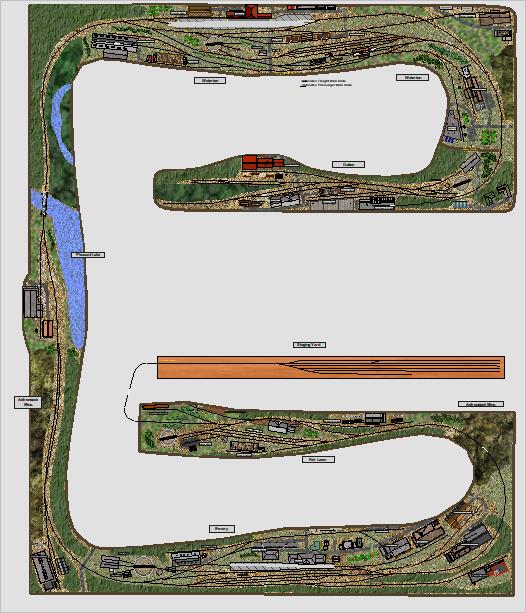 |
| Avast Line | 21 x 34 | This narrow gauge layout is based a timber and mining line in the western Colorado mountains. Steep grades abound and the result is shorter trains or a larger one with helper service. There is a mixed train run which stops at every station along the route. The main yard is located in Antigo and there is a western terminus beyond Glenburnie. Finally there is also a short interchange with the GWR at Avast. |
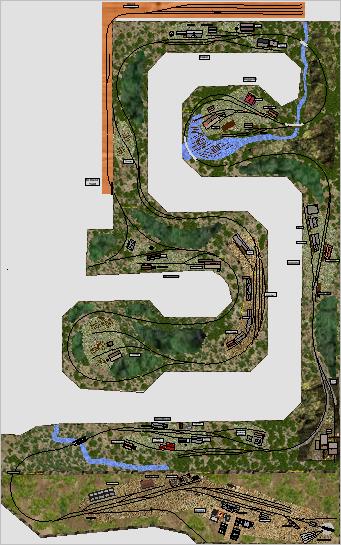 |
| BCR Dawson Creek | 38 x 108 | Timothy Horton's BCR Dawson Creek layout is the direct inspiration behind this plan. Tim's layout was featured in Model Railroader and you can read all the details of Tim's layout on his web site here: http://www.bcrdawsonsub.ca/. While Tim's layout is a 2 deck, around the walls plan, we have put all of his sub onto one level and have added a couple of mines where his helix would have been located. As Tim noted 'The 61 mile Dawson Creek Subdivision in 1977, featured trains that were anywhere from 5-35 cars in length and required 1-3 locomotives. The typical consist included trailers, lumber, wood chips, ore and grain. The yards at Chetwynd and Dawson Creek were reasonably compact and most industries are located nearby these yards. The NAR and CPR interchanges are represented in the off plan Staging Yard and from there the various "unit" or "block" trains originate. |
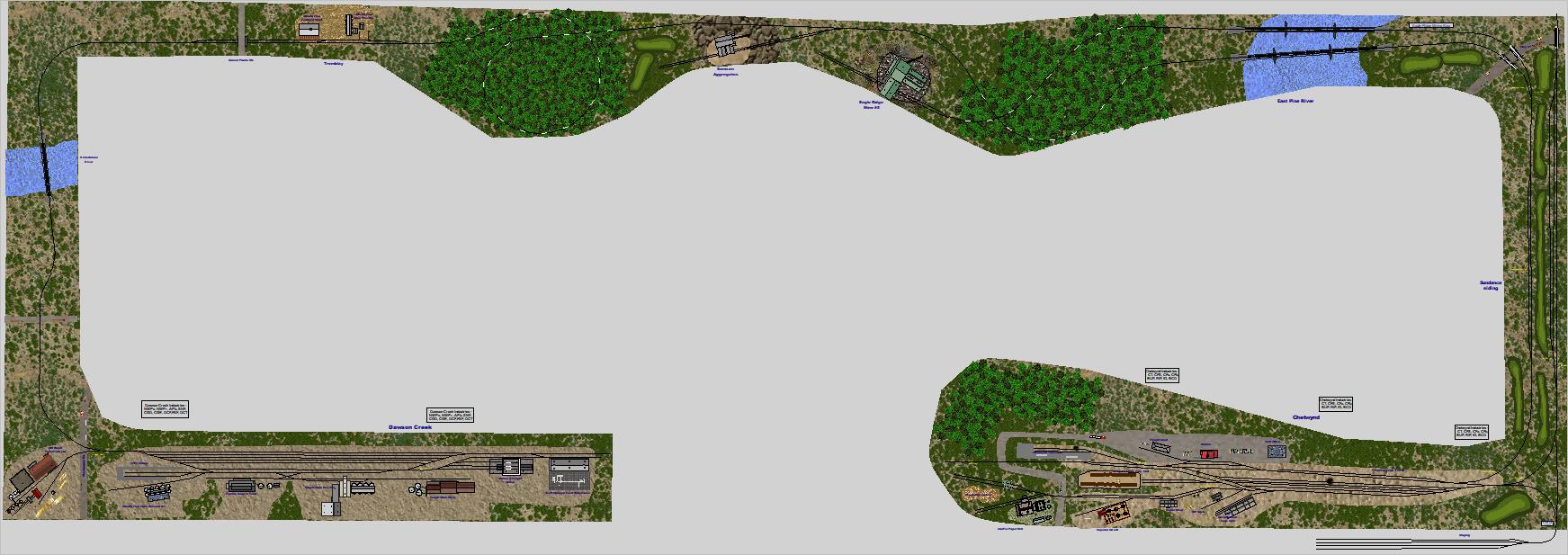 |
| Bendix Steel | 12 x 44 | Bendix Steel is a typical blast furnace operation complete with a rolling mill. It consumes a huge amount of coal, coke, limestone,ore and other raw materials and produces copious amounts of steel plates, ingots and slabs, as well as tons of useless slag during processing. As well there is a need for loads of bricks to rebuild / re-line furnaces, sand,lubricants, replacement parts and equipment. A plant this size has 3 of its own SW1500 switchers to move various raw materials around the site 24 hours a day. A nearby Class 1 will bring to the Staging Yard, dozens of loads of coal and ore to feed the furnaces as well as the other "incidentals" the mill requires for optimum performance. Two of the SW1500s are paired and work in combination or in "push / pull" mode separately. The third unit is the "Scooter" which does most of the Blast Furnace work and needs the 2 spacer cars to shield its engineers from the high heat of the molten steel loads. |
 |
B&O Chicago Jct. Line |
22 x 109 | The B&O Chicago Junction Line is a fictional interpretation of the actual line which ran through the upper north west of Ohio on its way to Chicago in the late 1940s. This area represents a typical north east line with some passenger service and lots of mixed through and way freights. The area was peppered with light and medium industries ranging from textile, manufacturing, produce packers, warehouses and food processing; along with industries like a cement plant, a dairy and a meat packer. |
 |
| Bowden Turn | 20 x 42 | The fictional Fox River - Bowden Turn starts at a smaller division point staging yard where trains are built and sent north and southbound. Bowden is at the far east of the division. From its small facilities, it sends out a daily tramp to stop at the various southern towns. Fox River has a similar pedlar job which services Fox River, Eden and the busy Eagle Mine. As for passenger service, there is a lonely doodlebug which shuttles between Fox River and Bowden on a daily basis |
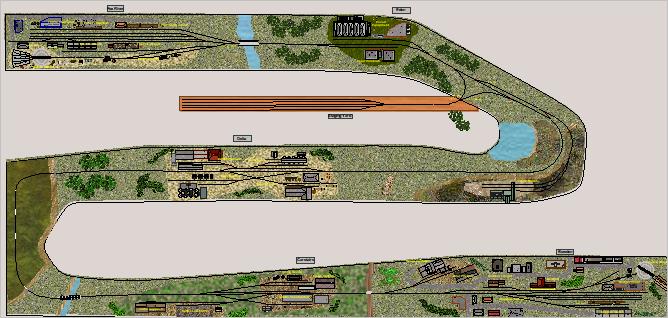 |
| Broad Top | 12 x 22 | Broad Top depicts the far end of a large rail division with 2 communities, each having a small yard which is linked back to the main division point yard [Staging]. Along this district's route, there are 5 switching zones with a mix of industry types typical of the north east of the US in the modern era. |
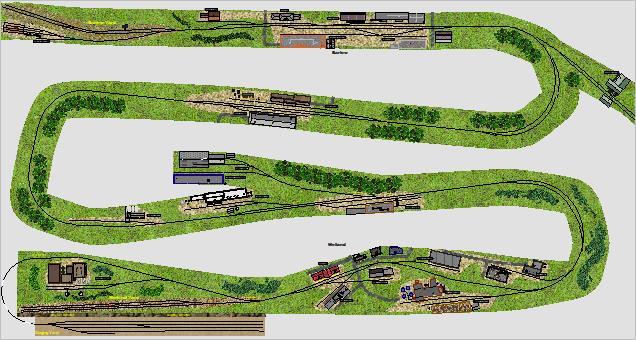 |
| Clear Creek | 13 x 58 | Clear Creek is loosely based on the track plan of Harry Brunk's classic 800 square foot Union Central and Northern Model Railroad as it appeared after being rebuilt into a dedicated mobile home "Little Colorado" in the Mid 1990's. The layout outlasted the mobile home and is now on permanent display at the Cheyenne Depot Museum. https://www.cheyennedepotmuseum.org/model-railroad I have taken a few liberties with Harry's 1995 track plan to maximise the operating potential for TrainPlayer Advanced Ops. These changes include restoring the wye at Georgetown which existed on the 1980's version of the layout, adding a run round loop on the approach to Blackhawk, changing a large coal yard at Idaho Springs into a small engine facility, and moving the Forks Creek siding from the West to the East of the station to ensure that the operator is always aware if there is transfer traffic to pull. Crews of Eastbound Freight and Ore trains should not leave Silver Plume without first checking the Mining Industries at 1MI for Eastbound traffic. Richard Fletcher, November 2018. |
 |
| Clearwater Sub CSX | 23 x 27 | This large layout, set in the modern era, is inspired by Lance Mindheim's various layouts based along the Florida east coast line around Miami and Fort Lauderdale. Many of the industries revolve around the mainstays of the local economy - fresh fruits and vegetables, with a sprinkling of light manufacturing and service industries. |
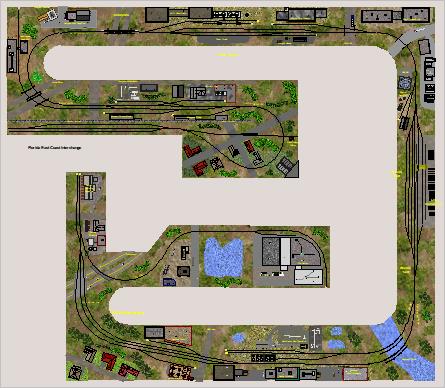 |
| Central Nova Scotia RR | 20 x 30 | The layout, based on Robert Chant's Central Nova Scotia [CNS] Railway, is a point-to-point plan set in the early 1930s time period. The CNS lines ran through much of the province of Nova Scotia and, in the city of Sydney, it services the many lumber and related light industries along with a brewery, a dairy, a food processor and a couple of fuel depots. The switch crews in Collins Yard are kept busy. |
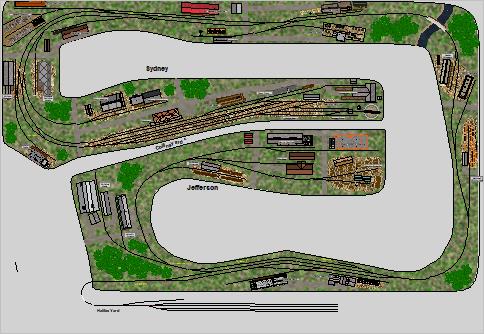 |
| CP Stoney Creek Subdivision | 24 x 128 | This plan depicts a typical but fictional Canadian Pacific RR subdivision in south central Ontario in the late 1940s era. Steam was still "king" and there was even a twice daily passenger service running through the Sub. But freight service brought in major dollars from this area with its blend of mixed light industrial, food services and natural resouces based businesses. Near the south end of the plan, there is an interchange with the CNR which exchanged numerous cars daily for the Grenville and Stoney Creek based industries. |
 |
| Crossing the BAR | 33 x 34 | The Bangor Aroostock Railway [BAR] served as a bridge route between Canadian railways and their US counterparts in Maine. The BAR was also noted for hauling potatoes to markets in Boston and New York in insulated boxcars from 1895 to the late 1950s. Throughout its history, the BAR also did a lot of business with several sawmills and pulp and paper plants which dotted its operating area. For freight OPS, the St. Regis Mill is one of the BAR's largest customers and it generates incoming chemical and log loads and outbound loads of woodchips and paper products. A switcher out of the Searsport yard services this mill with cars from staging. There is also a daily BAR tramp freight which provides service to industries in Caribou and Presqu'ile as well as Dawkins and the MEC Interchange in the south. As for passenger services, the CNR's "The Canadian" which is a daily train, makes a couple of stops on its way south to New York City. |
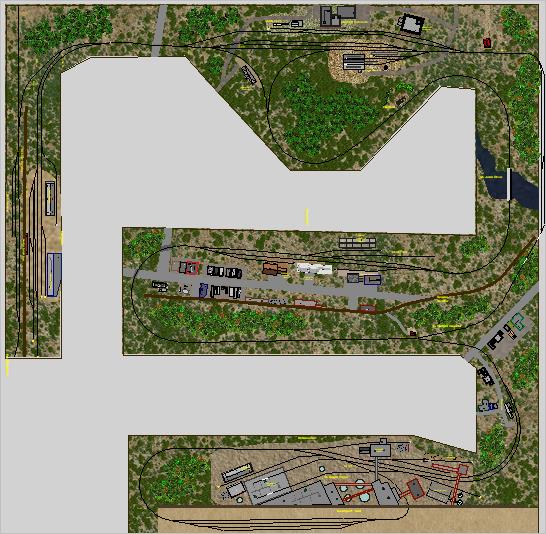 |
| Cumberland Subdivision | 54 x 77 | The Cumberland Subdivision is a fictional club sized plan, set in the late 1940s with plenty of industrial sidings, lots of yard work and some active passenger service to keep you busy and interested. The Cumberland Sub has several Districts - Drayton, Ellis, Flagstone, Garden City and Hillsdale included within its operating area. Each community has its own blend of light and medium industries that are rail served. The Flagstone District is home to a large grain mill and a coke and coal business which are directly served by a specially blocked train. The other Districts are serviced via a transfer job fromthe Sub's main yard made up of inbound loads / empties to fill shipping orders and which pulls all cars spotted in the various classification yards and headed back to the main Sub Yard. A modest passenger service is still operating and it services the various towns along the line on a twice weekly basis. |
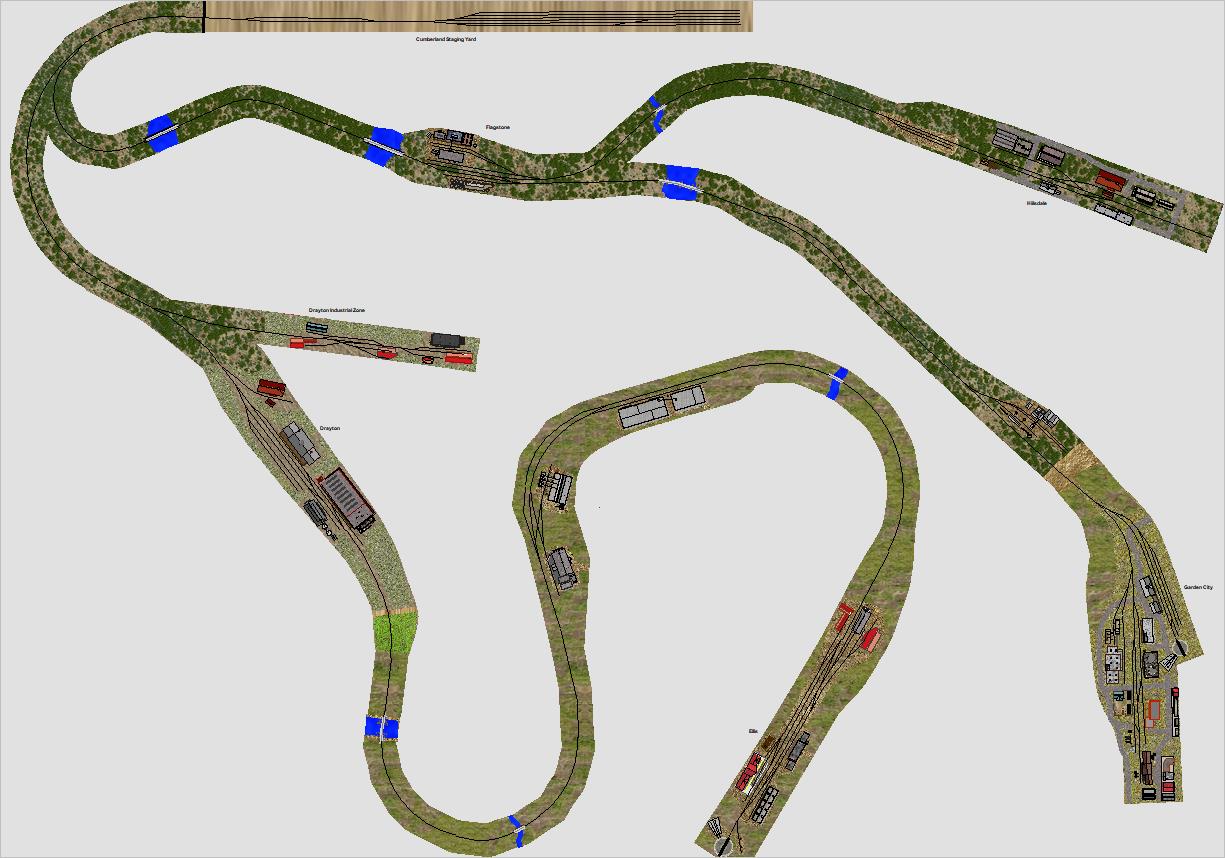 |
| DEM&S RR | 21 x 45 | The DEM&S is a 3 foot narrow gauge shortline railroad in the foothills of the Rockies. Its main source of revenue is hauling ore from the Hard Rock Ore mine and moving timber and logs between McKenna Timber Camps and the Sawyer Sawmill and then on to distant markets. The main centres are Dason and Sanders, while this portion of the line services a number of industries around the towns of Elgin and Marlon. The country side is fairly rugged and most trains are generally short. If you have more than 12 - 15 cars, you must enlist a Helper engine based in either Elgin or Marlon to keep your train moving along. Alternatively, you can break any train into smaller "sections" which can be handled by a single engine. |
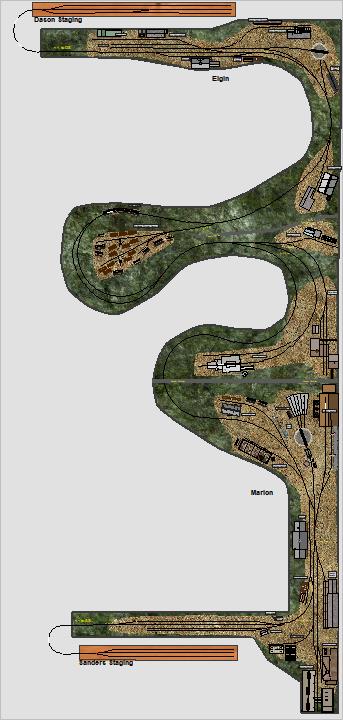 |
| DWP Red Wing Branch | 25 x 29 | The Duluth, Winnipeg and Pacific Railway is a subsidiary railroad of Canadian National Railway. The DWP line is CN's connection between International Falls and Duluth, Minnesota, where the railroad connects to a short stretch of the former Duluth, Missabe and Iron Range Railway before following the former Wisconsin Central to Chicago, Illinois. The fictional Red Wing Branch in the 1960s era is a typical small branch encountered in Minnesota. It consists of mainly warehouses, grain & feed mills and some light industry. But there are 2 large "anchor" industries here as well - McCone Energy which converts corn and grains to ethanol fuel and International Paper Products which takes in pulpwood and ships rolls of newsprint. These two customers supply the branch with a lot of its traffic movements. As well, there is bridge traffic and a RDC passenger service running in both directions from Duluth to Chicago. |
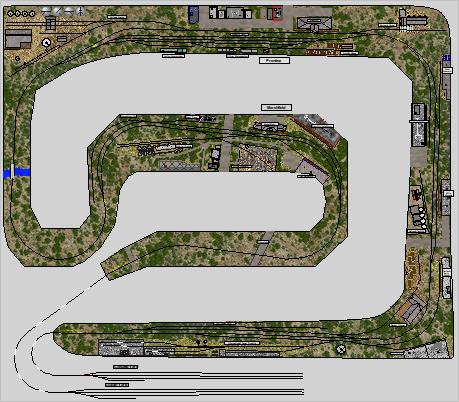 |
| Exeter, Foxwood & Grantly Railroad | 43 x 73 | Exeter,Foxwood & Grantly Railroad is based on a large FREMO display layout. It is a point-to-point plan with 3 good sized yards and an interchange with the mighty PRR. The EF&G RR provides both freight and passenger services over a largely single track mainline. Local industries include typical lumber yards, grain & feed mills and a small coal mine. There is also bridge traffic running over its line to reach the PRR interchange near Grantly. |
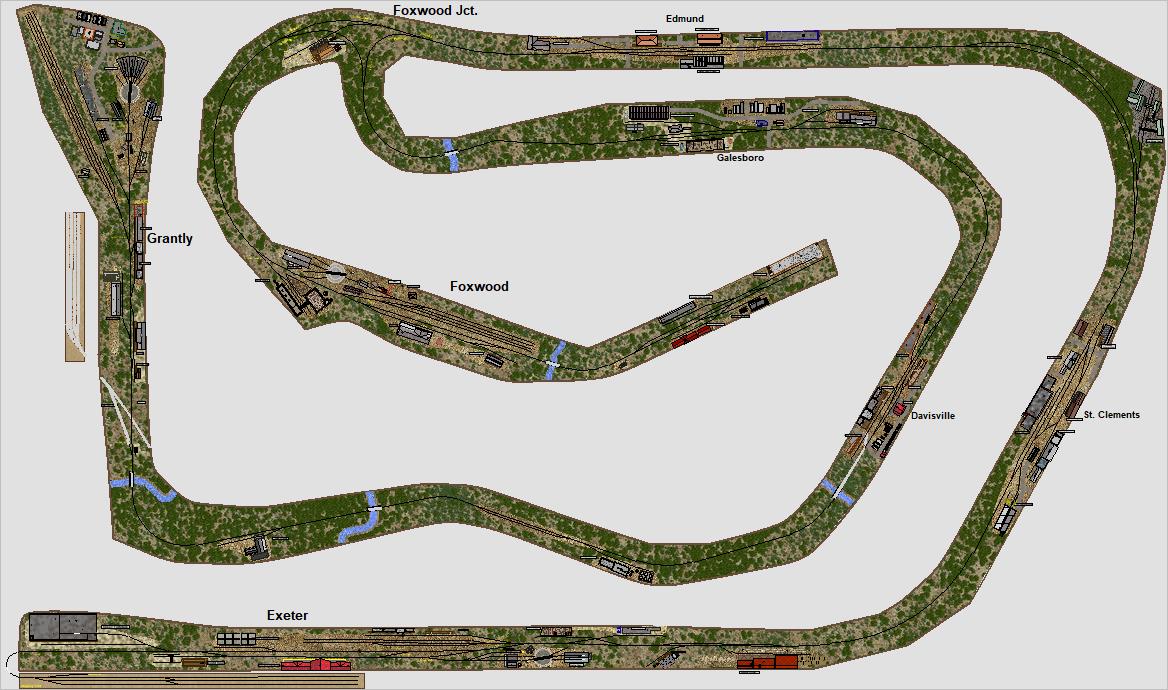 |
| Everman Sub | 32 x 78 | Everman Texas is a suburb of Fort Worth. There are several large industrial estates spread throughout the area and Everman is home to some good sized businesses with lots of rail traffic. The major customer in this particular development is Miller Coors LLC, the brewers who receive/ship 40+ cars per day. All operations start at the Staging yard located on the south east side of this plan. |
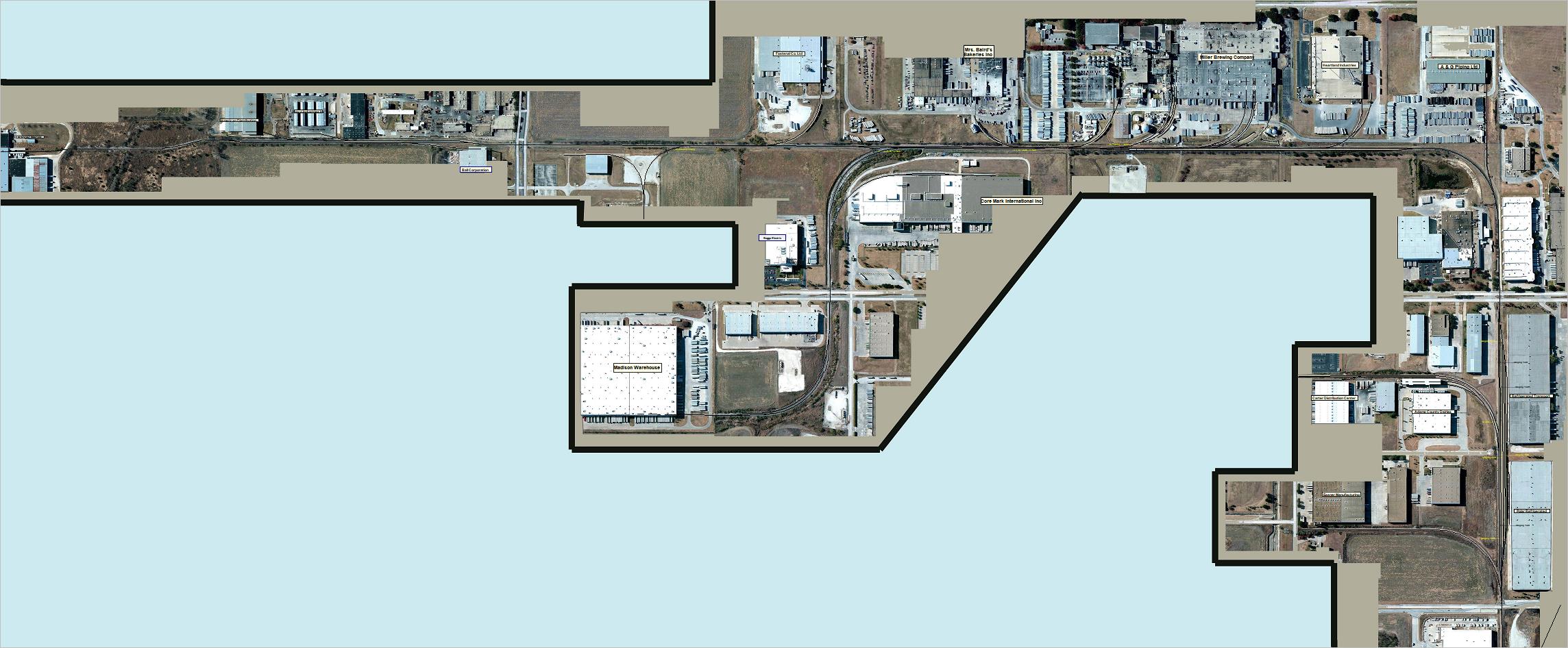 |
| Fairfax Branch | 39 x 47 | The Fairfax Branch is set in the post 1980s era. It is a club sized modular railway which features several mid-sized resource based industries, along with some light manufacturing and topped off with a major cement plant operation. Most of the rail cars enter and leave the Branch via the Davisville Yard in the south. The Davisville crews look after the needs of local industries as well as those based in Nordberg. The Davisville engines run a daily express freights to Cemex to keep their revenue cars flowing through. The Cemex plant has its own switch crew who look after a busy daily turn to keep the cement mill humming at full production. This layout is inspired by the designs of Robert Sprague whose work can be viewed on his website - www.bobstrackplans.com/plans. |
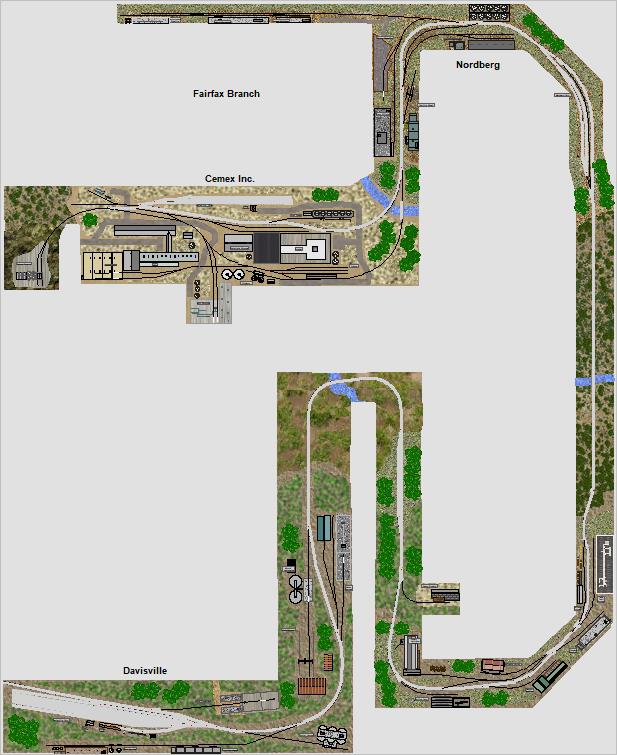 |
| Fremont Branch | 19 x 47 | This plan was based on a FREMO modular display layout. It is set in the modern era, with plenty of switching moves for you to do and some long runs to view your long trains. Many of the industries revolve around the interchange traffic with the CNJ and the GM Engine plant in the south and the Ameri-Steel rolling mill near Fremont, with a sprinkling of light manufacturing and service industries throughout. |
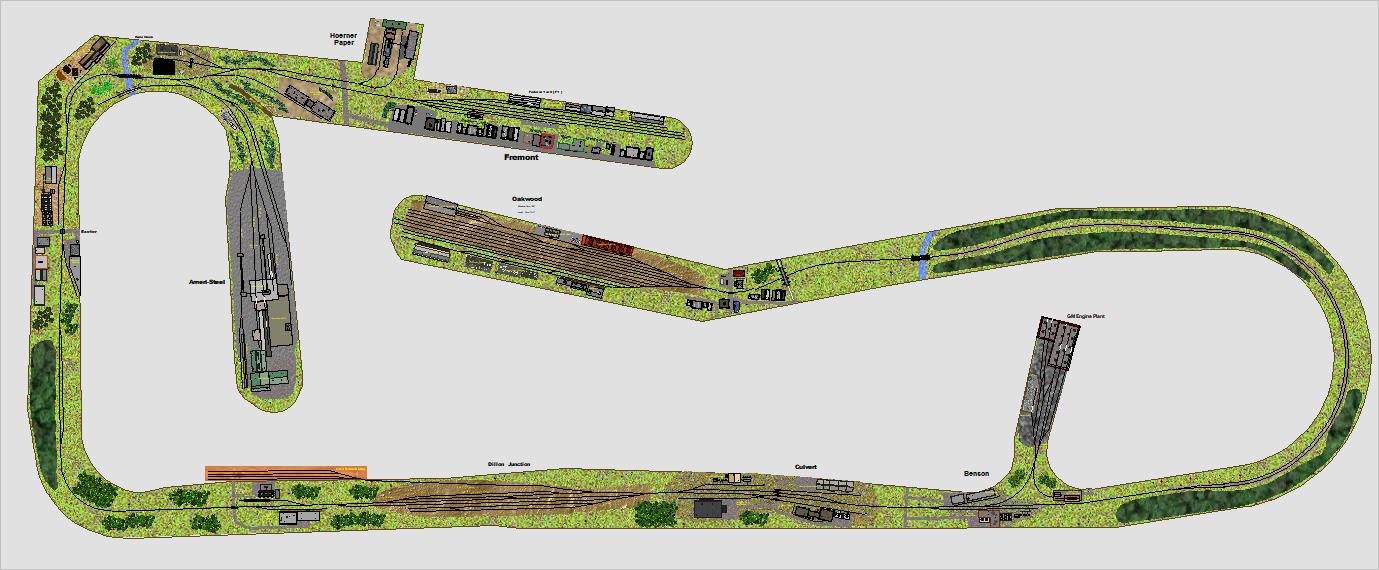 |
| Fresno District | 23 x 27 | This point-to-point layout depicts many actual industries in and around the city of Fresno, California. Fresno covers about 112 square miles in the center of the San Joaquin Valley, the southern portion of the California's Central Valley, and as such it is predominantly tied to large-scale agricultural and natural resource production. The industries on this plan are similarly based on natural resources [paper, lumber and building materials] and agricultural production [grains, fruits, vegetables, and a distillery]. The Calwa Yard at the top edge of this plan is a critical link with the BNSF and the UP class 1 railroads. Fresno's rail customers are served by the San Joaquin Valley Railroad, a class 3 shortline with track rights on both the UP and the BNSF. |
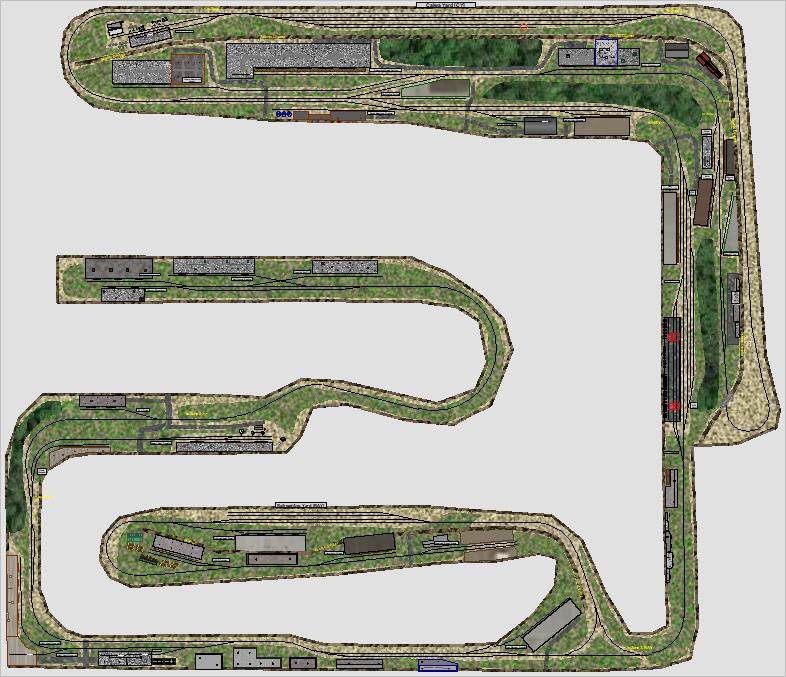 |
| Frisco Central Division | 53 x 102 | This is a modular FREMO style layout with plenty of operational potential based on the St. Louis-San Francisco Railway [SLSF], also known as the Frisco, which operated in the Midwest and South Central U.S. from 1876 to April 17, 1980 In the era depicted - 1965 - 1980, freight haulage provides the majority of the Frisco's revenue. The chief industries were the oil fields near Tulsa, coal at Coal Creek and some lumbering and grain operations as well. Fort Smith had a sizable yard in the Frisco's Central divison and much of the coal and lumber passed through this yard on its way to its end market. There are dedicated, coal and lumber drags along with mixed way freights for you to operate. |
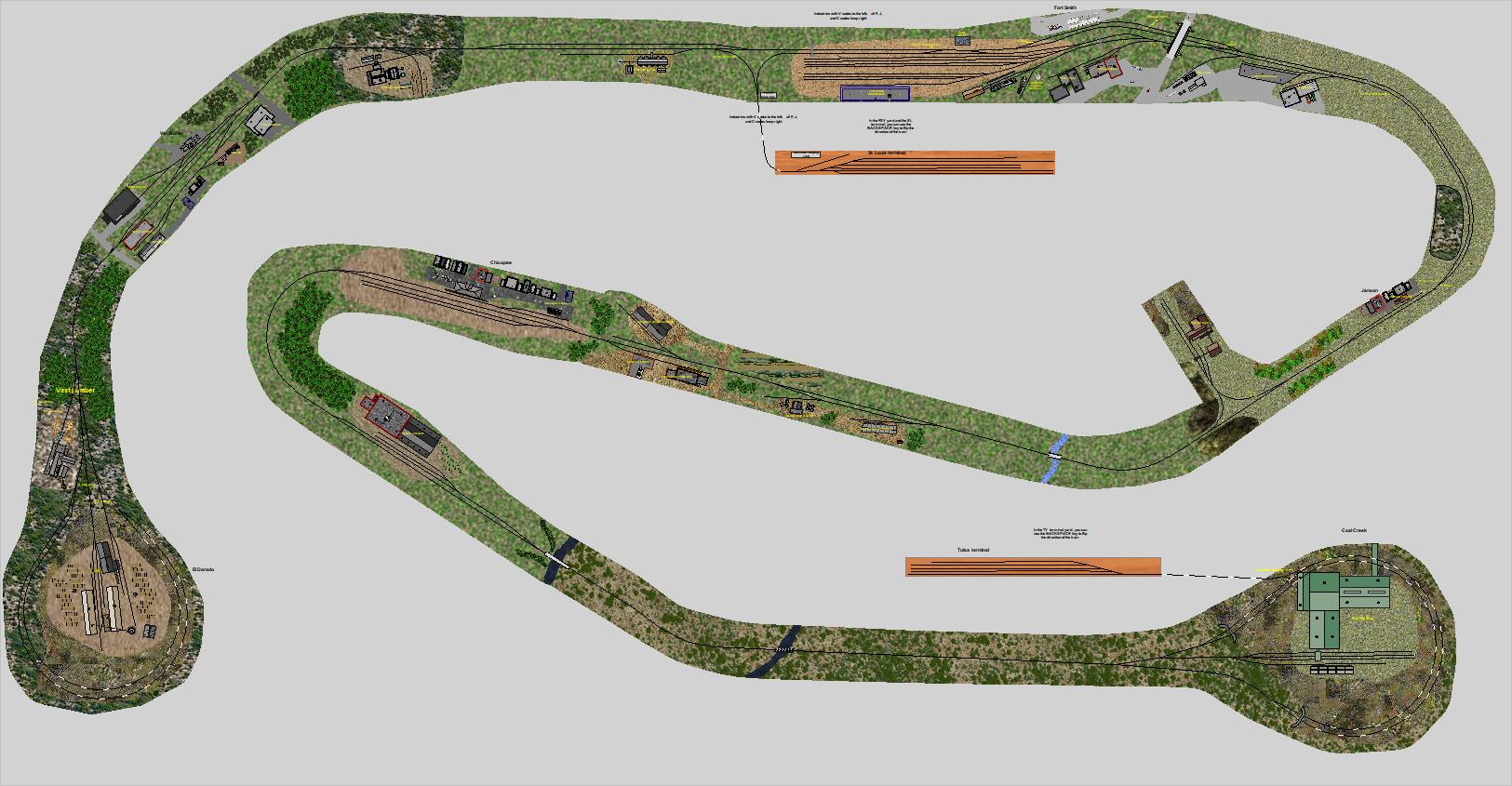 |
Gilpin Tram Railway |
26 x 72 | Gilpin Tramway was built as a solution to a transportation problem in the 1890s when the alluvial or surface gold disappeared and strip and shaft mining began in the gulches and ravines in the lower Rocky Mountains of Colorado. The Gilpin Tramway was built as a 2 foot narrow gauged line. From the mine locations in the gulches, its trackage worked its way back down Clear Creek climbing the sides of the hills and climbing up into Gregory Gulch. The maximum grade was a steep six percent. Much of the altitude gained by the Gilpin was done by the use of switchbacks. The Tram had more switchbacks than any other American railroad. At one point, seven switchbacks were used to reach a single mine. So as a result, the Tram relied on 3 Shay geared steam engines and ran relatively short trains. Once the raw ore from the mines was placed in hoppers, it was then ferried down to the many stamping mills in Black Hawk. There, most of the gold ore flowed through the mills in linear process: crush, amalgamate, concentrate, and process concentrates. At the end of this preliminary cycle, the concentrated ore was forwarded via a connection to the Colorado & Southern 3 foot narrow gauge which forwarded to Denver and California for further smelting and purifying. The Colorado & Southern was also the primary source of supplies, coal and food that was required by Black Hawk and its residents. In addition to a daily turn of the mills and the Black Hawk yard, the C&S also ran an alternate day "mixed" train for passenger and essential services to Black Hawk and Central City. As profit margins for mining gold ore steadily declined after 1910, the Glipin Tram fell on hard times and was sold for scrap in 1917. |
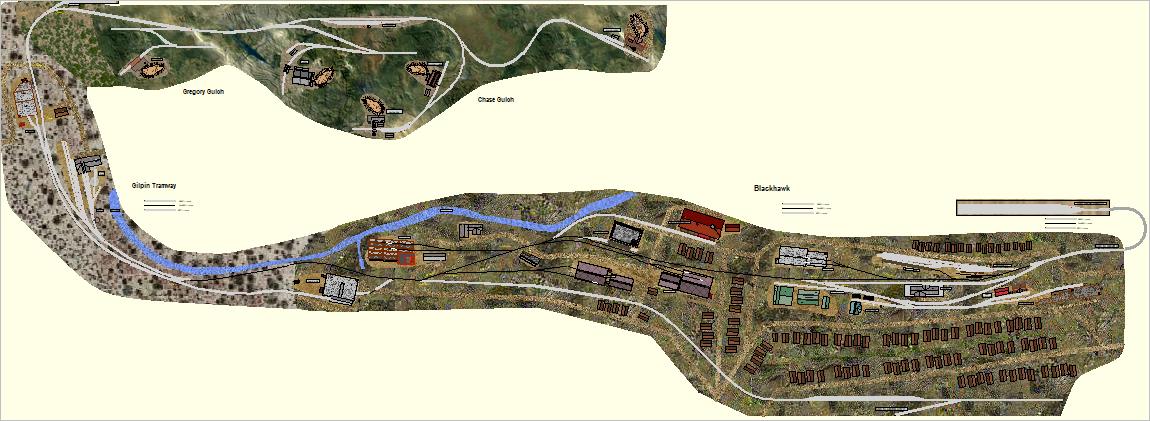 |
| GN Everett District | 25 x 31 | The GN Everett District design and track plan was created by Byron Henderson [used with permission]. The major operating center of the layout is the town of Everett, which boasts a small yard and three good-sized grain elevators. Grain elevator operations are also seen at New Flora and Tatanka, with the elevator tracks separated prototypically from the main track and siding. There is also an interchange with Southern Pacific RR, along with an at-grade crossing near New Flora. The Staging Yard above Everett provides plenty of capacity for through freight and passenger trains. This room sized granger railroad should offer lots of operating interest while still preserving the "wide-open-spaces" feeling of the area with plenty of running room between major towns. |
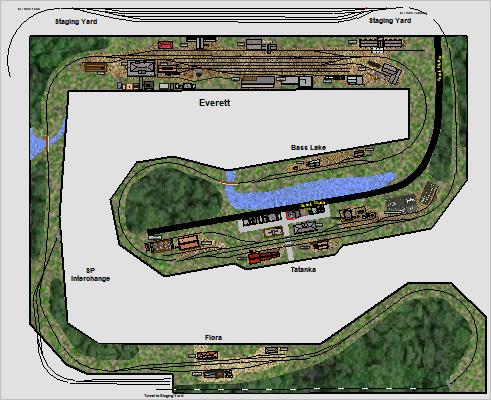 |
| GTW Pontiac Line | 28 x 32 | The Pontiac Line of the GTW travels west from Detroit to Chicago, through the industrial heartland of Michigan. The area is decorated with all types of secondary industries which feed into the area's giant auto manufacturers. |
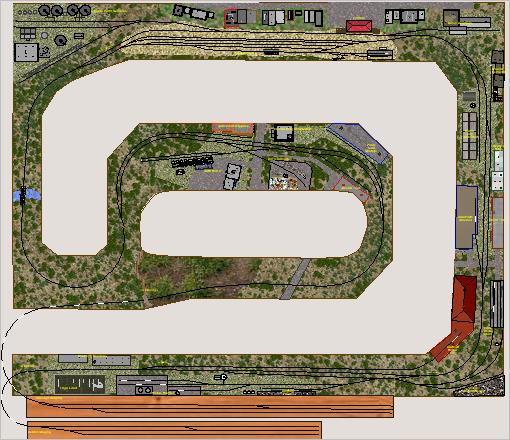 |
| Hagersville Branch | 15 x 18 | The Hagersville Branch of the CPR during the 1900 - 1930 period generated lots of resource loads, principally cattle and grain for the CPR. At the same time, as the area expanded, the demand for equipment, building supplies and essentials grew as well. This provided a good flow of inbound traffic for the railway. |
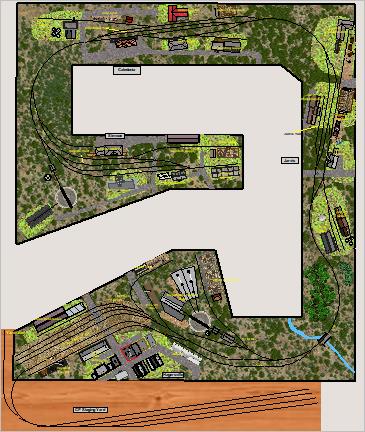 |
Illinois midland |
15 x 92 | This club sized plan is based on a design by Christian Javier and it was subsequently modified into a point-to-point layout on one level. This subdivision runs through the heart of Illinois and features some mid to large size industries and grain elevators as well as a busy transload operation at the Berkeley ara. The era is the late 1990s - modern period. |
 |
Indiana Division 3 |
8 x 37 | The fictional Indiana Division 3 is a point to point plan that focuses on the operational aspects of this division. By that, we mean it places most of the rail served industries on the layout as though they are all close to each other when in fact the division extends for 70+ miles. There is a small classification yard to service each section of the Division and there are several "through" freights which also traverse this division daily. We will only provide two of those through freights. The industries represent a cross section of light manufacturing, food processing, supply and distribution businesses. |
 |
Jackson Division |
36 x 43 | The Jackson Division is a fictional depiction of a division of the GTW railroad in the US mid-west in the early 1960s. The main staging yard is located in Jackson and passes through several smaller towns until it reaches Redstone where the mainline ends at Redmann Yard. A branch line continues to an Interchange with the UP railroad but it is not modelled here. There are 7 towns with rail-served customers Jackson, Lincoln, Muncie, Nicholl, Park Lawn, Quinte and Redstone. There is a daily RDC passenger service - the Red Wing, which originates in Jackson stops at each town before layover in Redstone. In the afternoon, the Red wing returns to Jackson after stopping in every town along the route. There is a daily express train between Jackson and Redstone which pulls cars from each classification yard it visits, and drops inbound cars for each yard as well. In between times, there are several local trains to service the business customers in each town. As well, there are 4 daily unit trains to service the grain elevators, the transload facility and the Muncie Coal mine. |
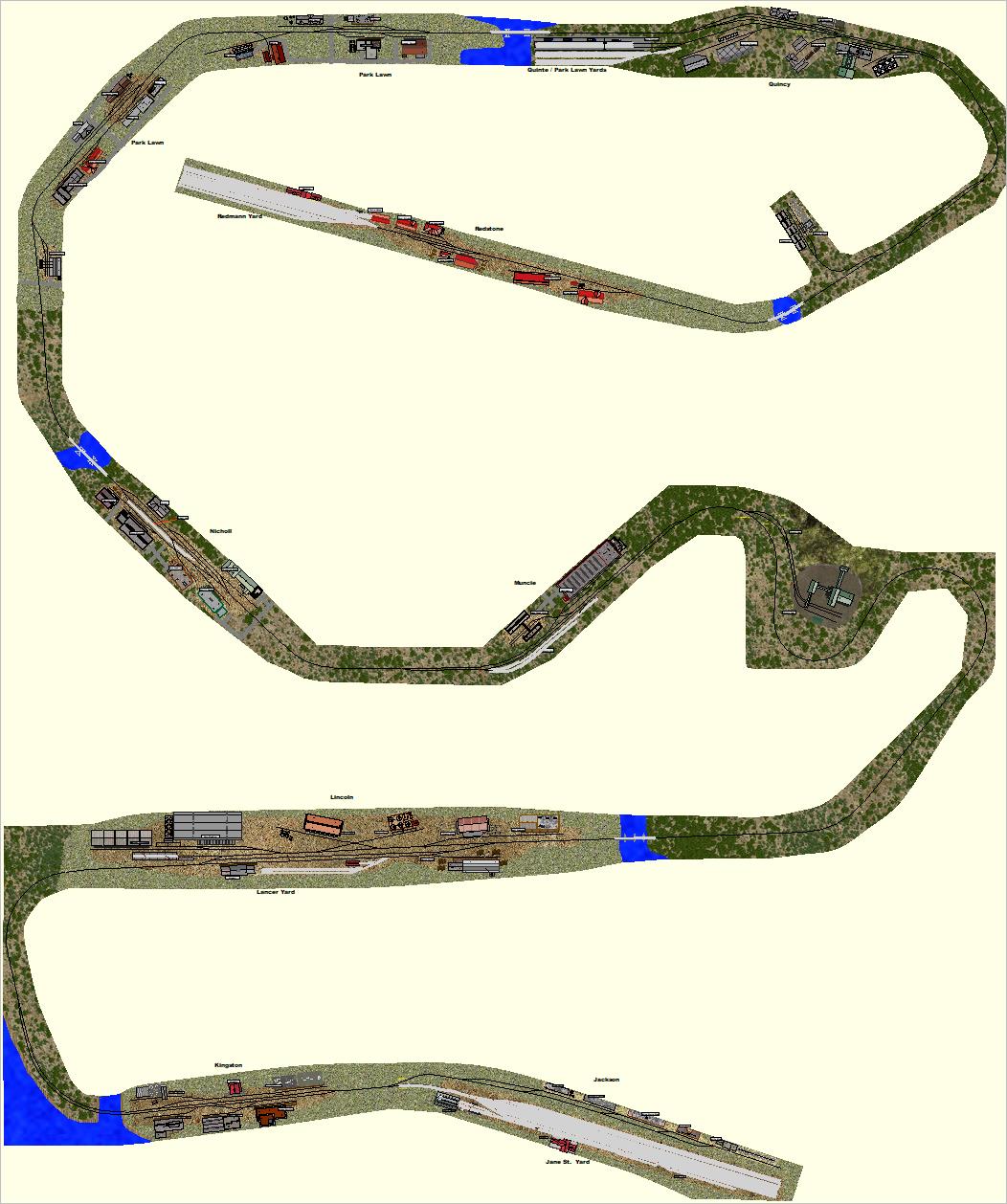 |
| Jonesbury District | 23 x 78 | Jonesbury District is a point to point layout. Formerly a double decker plan, we have redesigned the layout to a single level to facilitate a more complete operations plan. Cars are moved between Ekland Yard on the top left in an westerly direction headed to Jonesbury yard on the east side of the layout. There are 3 major customers - Farmers Co-op, Triangle Plastics and Marden Cement whose daily needs are handled by a unit train out of the Jonesbury Yard. Along the route there are several light and medium industries to be switched by the daily way freight. |
 |
| Kortland Subdivision | 72 x 121 | The Kortland Subdivision is a fictional rendition of a good sized subdivision in the late 1940s which includes a main Staging area at Kortland and 12 classification yards spread over 12 small towns. There are about 80 industries to service ranging from grain to ore to coal resources and typical mixed light industrial businesses. Passenger service is dwindling in the late 1940s but there is still enough demand from the 12 towns to support 3 daily passenger runs of various schedules. This plan includes 19 trains on its daily schedule [Sequence] and there is enough work to keep 16 steam engines and 1 new diesel very busy. |
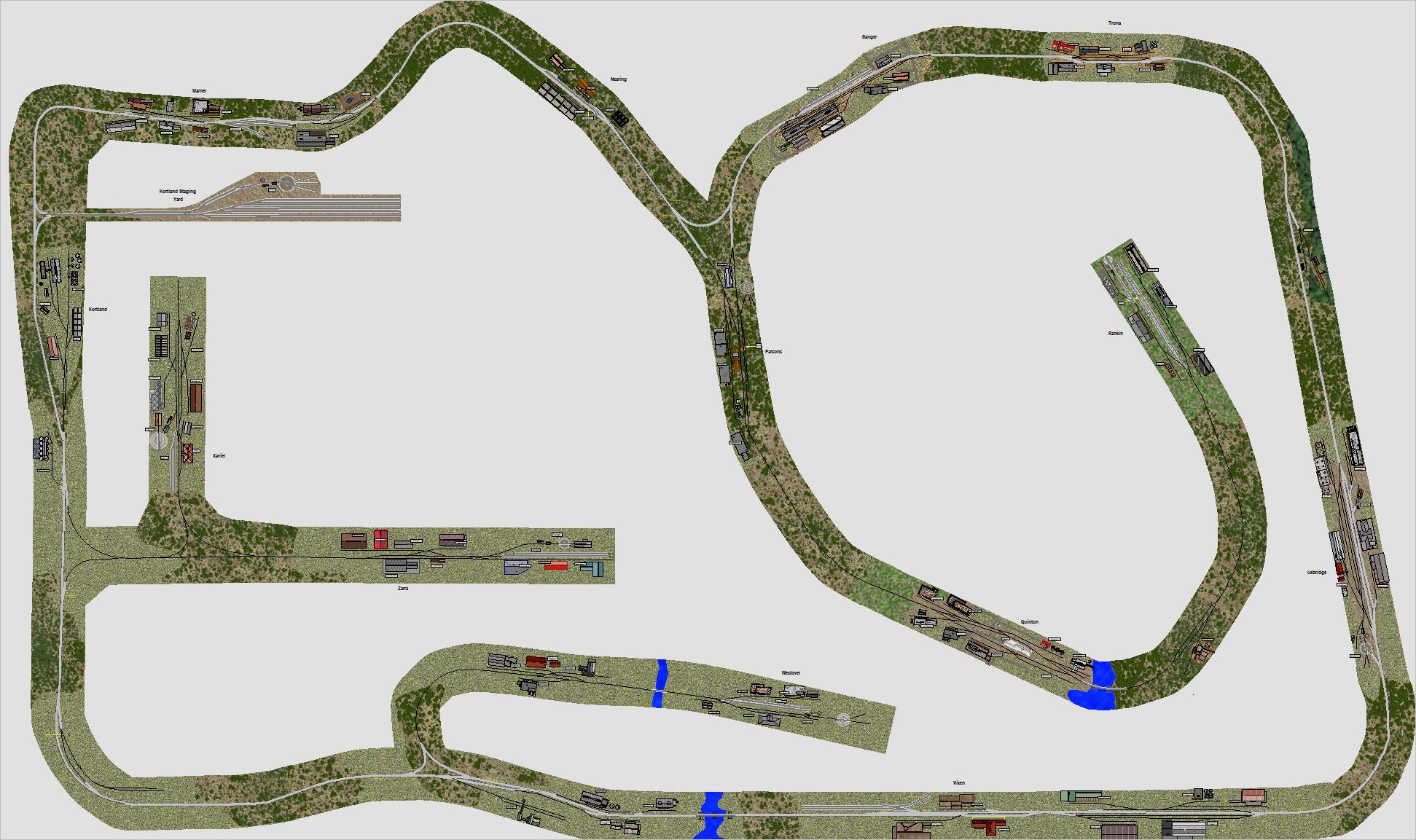 |
| Llareggub | 10 x 26 | Llareggub is a fictional 2ft gauge railway set in the North Wales hills. It was built to carry roofing slate from the quarries at Cefn Ddu to the sea at Llareggub. Although slate traffic still travels this route, the Standard Gauge railway has now arrived at Alt Yr Eryr. This has generated a completely new outlet with fish from the ports and produce from the dairy being routed through the transfer yard at Allt Yr Eryr to all the major cities of England. |
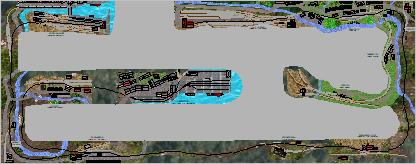 |
| Lubbock Industrial Districts | 26 x 37 | Our Lubbock Industrial Districts by David Barrow is an adaptation of his plan which appeared in Model Railroad Planning 2006. This freelanced, club sized plan looks at several major industrial districts on the ATSF in Lubbock, Texas. The double-tracked main line would normally see 5 or 6 through trains per shift along with 1 or 2 locals which switched the various industries. There are 4 industrial zones involved and not all of them have runaround tracks. So it is important that you "block out" your train before heading out from the classification yard. |
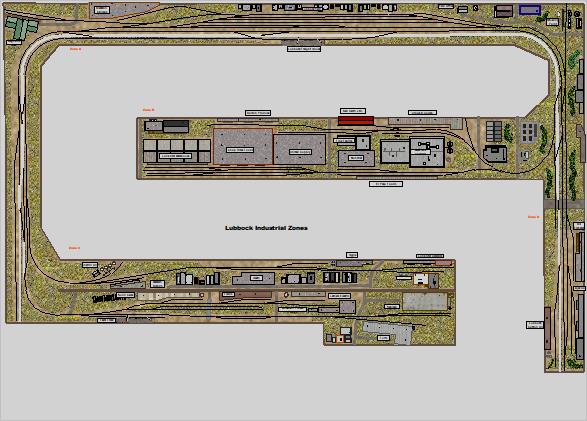 |
| The Sandy River and Rangeley Lakes RR | 13 x 32 | Promoted as the Maine Scenic Route, the Sandy River and Rangeley Lakes Railroad operated in Franklin County, Maine, between 1879 and 1936. It was the largest of the Maine "Two footers" and in its heyday had more than 115 miles of two foot gauge track. This TrainPlayer layout is an attempt to recreate some of the nostalgia. There are six different routes for you to operate, The Rangeley Turn, The Woodsman Logging and Pulpwood Train, The Phillips to Farmington Local, The Kingfield Turn, The Bigelow Pedler and a Railcar link between Kingfield and Farmington. There is currently no passenger service on the Bigelow branch but you will usually find a couple of passengers hitching a ride in the caboose. You start your day at the Farmington transfer sidings and should begin by moving the passenger combine to the platform for loading. There are six different routes for you to operate, The Rangeley Turn, The Woodsman Logging and Pulpwood Train, The Phillips to Farmington Local, The Kingfield Turn, The Bigelow Pedler and a Railcar link between Kingfield and Farmington. There is currently no passenger service on the Bigelow branch but you will usually find a couple of passengers hitching a ride in the caboose. Each time you generate a new switchlist you will be allocated a different train. The routes are such that on some journeys a car will only travel part of its route and need to layover at an intermediate classification yard to await another train. In all cases the next destination for each car will be clearly shown on the car top. It is permissible to use the Yard Goat at Phillips or Farmington for assistance with switching the yard. You may also use any additional engines found on the branch lines. You must stop the combine at all stations marked on the car top to transfer passengers and parcels, and update the destination board. The first character of the label shows the locality. e.g. S = Strong, P = Phillips, R = Rangeley, M = Madrid. The first two characters show the actual spot. e.g. RT = Rangeley Team Track, PM = Phillips Toothpick Mill. |
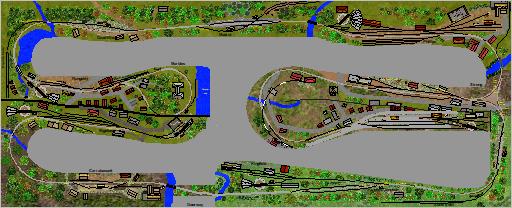 |
| Marchand Division | 41 x 64 | The Marchand Division is a based on a fictional short line which operates in the US mid-west south of Chicago. It has connections with Class 1 railroads which are accessed either via Decatur or their Peoria Yards. This division includes 5 mid-sized communities with a good mix of medium manufacturing and agricultural based industries which require regular rail service. As well there is a modest coal mine en route which is serviced daily as well. |
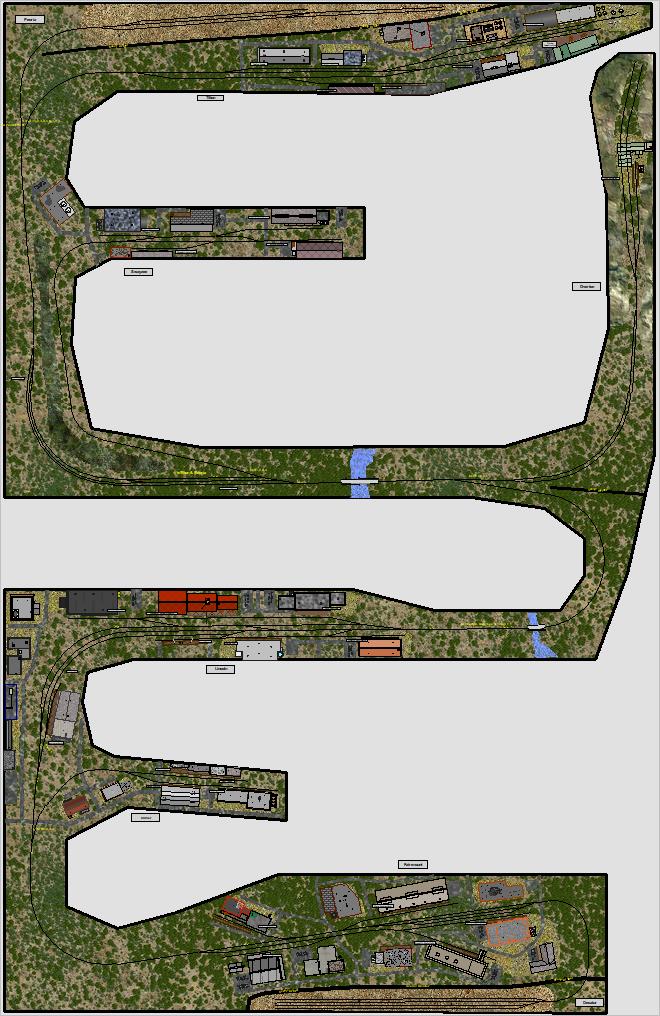 |
Mercer Branch |
12 x 31 | The fictional Mercer Branch is a part of the sprawling 1950s era Southern Pacific RR south western services. At the tail end of its subdivision in New Mexico, it is home to a few small light manufacturing businesses, a couple of produce packers and a mid-sized cardboard plant. There are a couple of runaround tracks on the branch to ease your switching duties. |
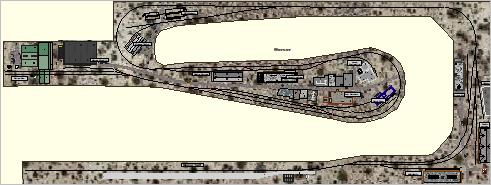 |
| Middlebury | 19 x 29 | This club sized Middlebury layout is based upon a much larger 2 deck plan by Byron Henderson. We have modified it to a single deck with the staging yard level at the bottom of the screen. There are several mixed light industries to service along with a coal mine, a grain mill and an interchange. As well, there is a small classification yard in Middlebury complete with a 2 stall engine house and RIP track for minor repairs. Enjoy! |
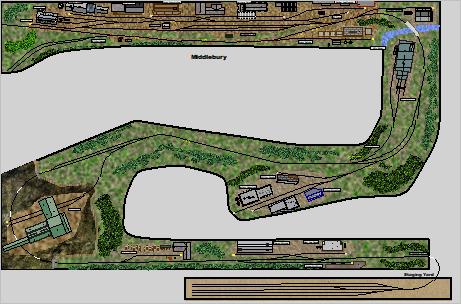 |
| MILW 14th Sub | 11 x 12 | This layout is modelled after a similar plan which appeared in Model Railroader magazine in 2012. As depicted, this point-to-point layout is based in the steam-diesel transition era of the late 1940s to the early 1950s. The twice daily car ferry serves as a floating 'yard' generally bringing in loads and empties required by the local industries. The largest customer in this area is the Cascade Paper company which has its own steam switcher and yard |
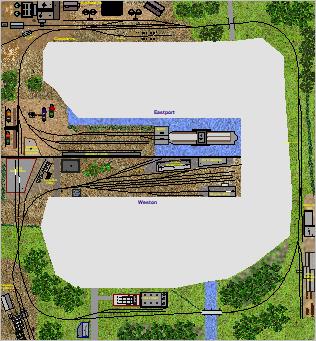 |
MILW - Beer Line |
6 x 84 | The Milwaukee Road's Beer Line has been featured a few times in Model Railroader magazine. This particular modified plan is based on a version which appeared in MR 2012. The particular focus in this plan is serving the needs of both the Schlitz and Pabst breweries. But there are a number of light manufacturing and resources based industries to service as well, including 2 cement plants, an American Motors plant, 2 applicance manufacurers, 2 food processors, a boiler maker and assorted other plants. As well, there are 3 different teams tracks used by small business to receive and occasionally send goods to the wider market. The time period is the early 1960s. You have 2 GP30s to bring in and return cars from the Staging Yards. As well, you have a GP9 and an older SW1 near Hunboldt Yard to service the many industries. |
 |
| NYC Scioto Furnace | 29 x 38 | The NYC Scioto Furnace layout is a club sized plan which features a busy and active steel industry, a grain mill, a limestone and cement complex along with several other small to medium sized businesses. The time frame is the early 1950s during the transition from steam to diesel, when middle American industries were booming. Many different types of freight trains and operating roles are supported on the layout: local and yard crews working out of Portsmouth Yard, dedicated haulers between Portsmouth and Scioto Furnace, and the in-plant steel mill railroad, various freight "turn" jobs, and also a decent amount of passenger train operations. This plan is based on an original 3 layer design by Byron Henderson, a well known custom model railroad layout designer [ http://www.layoutvision.com]; a member of the Layout Design SIG and Operations SIG, and a past editor of the LDSIG's Layout Design Journal. Used with Permission. |
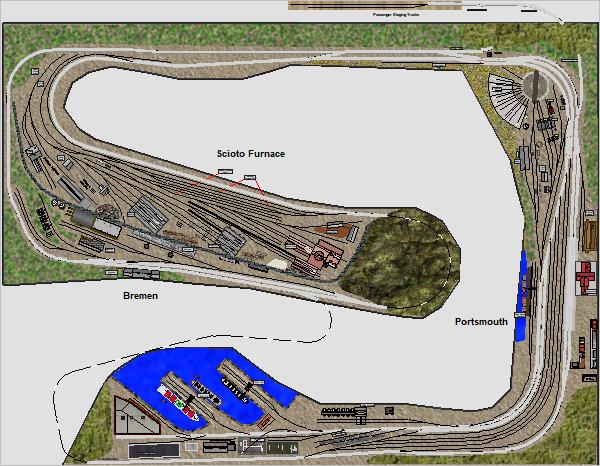 |
| Orangeville South branch | 48 x 65 | This is an entirely fictional CN subdivision based in south western Ontario. The Orangeville Sub is rich in natural resources which require rail transport - a gypsum plant, a lumber operation, a grain mill, a gravel pit and a coal mine. The main yard [Olin Yard] for this sub is located in Orangeville which is also one of the main pathways to rest of southwestern division. |
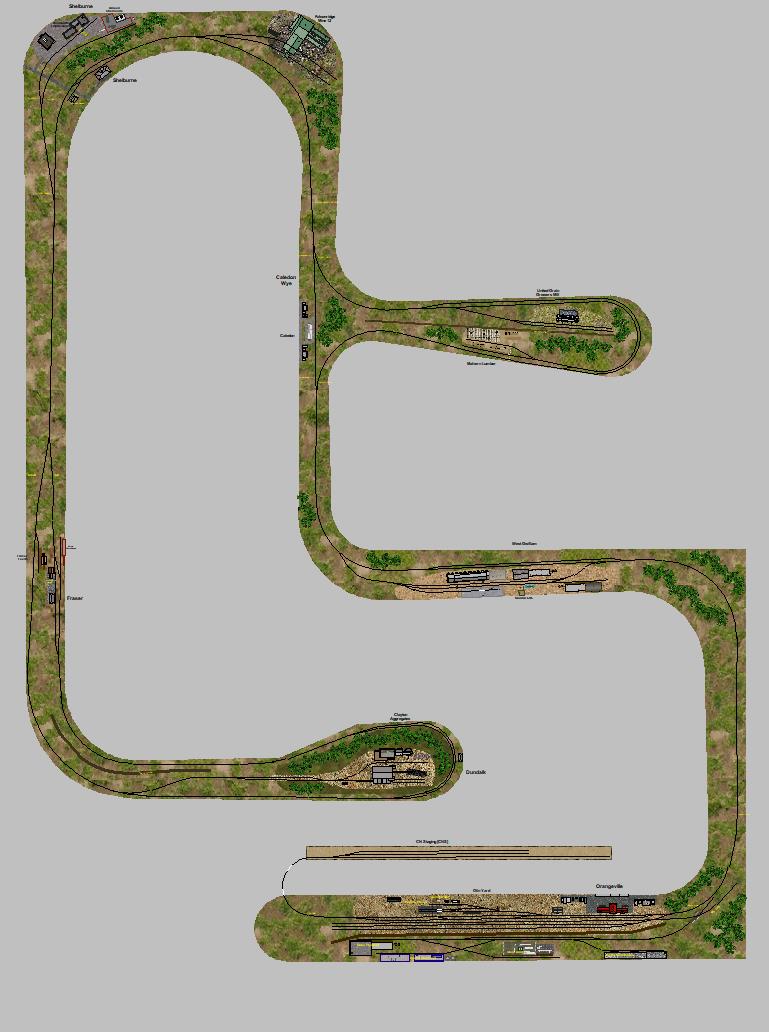 |
| Oxbow Sub | 25 x 32 | This fictional narrow gauge layout depicts life at the North Maine RR which is a short line railway supporting the local sawmill, an ore mine and a medium sized foundry based in northern Maine. This is rugged forest country and so the NMRR runs somewhat shorter trains of 8 - 10 wagons and a caboose. There is also Mixed train [The Coaster] which looks after the passenger and parcel services for the various stations along the line. |
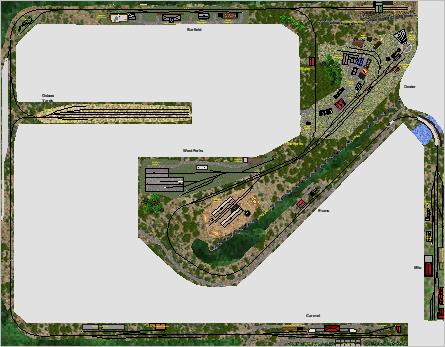 |
Port Colborne Harbour Railway |
30 x 195 | Bruno Pigozzo designed this layout for TrainPlayer 7.2 in March 2020. He was very familiar with the PCHR which operates on his home turf in Ontario. Bruno placed all the track, trains and foreground scenery, set up the working Ops pattern and wrote the introduction below. We don't have a copy of the layout with any background scenery but have chosen to only add plain baseboards to this plan. RIP Bruno you are greatly missed. RF for TrainPlayer Jun 1, 2020 Founded in 1997,the Port Colborne Harbour Railway (PCHR) serves 15 customers on our 50km long network located in the Niagara Region of Ontario, Canada. The PCHR, with its routes in the Niagara Region, provides responsive railway service to customers in Port Colborne, Welland, Thorold and St. Catharines, Ontario. Through interchange with Canadian National Railway (CN) and Canadian Pacific Railway (CPRS), customers are connected to the vast North American railway network and marketplace. This club sized layout, which is set in the 2010 era, is an interpretation of the major industries in each town and city which the PCHR operates. PCHR normally provides service to its customers five days per week, Monday to Friday. Traffic is interchanged the same day. The PCHR has 2 transload sites available in the Region which are usable for the transload of non-hazardous shipments from non rail-served customers. It also operates the WP Warehousing Distribution Facility in St. Catharines in a climate controlled facility with an attached tank farm. |
 |
| Pecos Canyon Route | 12 x 12 | The Pecos Canyon route is a fictional narrow gauge short line operating in New Mexico in the early 1920s. There are 4 major towns along the route - Comstock, Del Rio, Langtry and Sanderson where this line connects and interchanges traffic with the DRGS. The main customers are cattle ranchers, a lumber mill, a small copper mine and several related general service industries. |
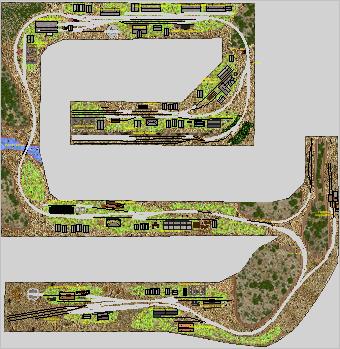 |
| Pelican Bay Railway and Navigation | 21 x 40 | Paul Scoles was a master railway builder known for his skills with creating scenery, buildings and industries and custom engines. His S scale Pelican Bay Railway and Navigation Company, narrow gauge layout took over his entire basement. Paul designed his point-to-point, PBRN to feature operations in the late 1890s in the Pacific North West region. The action begins in Main Staging Yard near Silverado where trains are assembled and head out for Pelican Bay and on to Klamath. |
 |
| Pittsfield Division | 43 x 63 | The club sized plan is based on only part of a very large FREMO display layout from 2016. The time period is the modern diesel era. The action is centered on the Pittsfield Yard in a major city in America's so-called Rust Belt. The main customers of the railroad are a cluster of steel based industries in the city of Morgan. There are two small branches headed to Carlyle and Huston and their local rail-served customers. There are also some smaller rail served clients in Newbury, Everest and Bedford at the other end of the division. While passenger service has long since given way to inter-state buses, there are still a good number of industries along the route to keep the local roadcrews busy. |
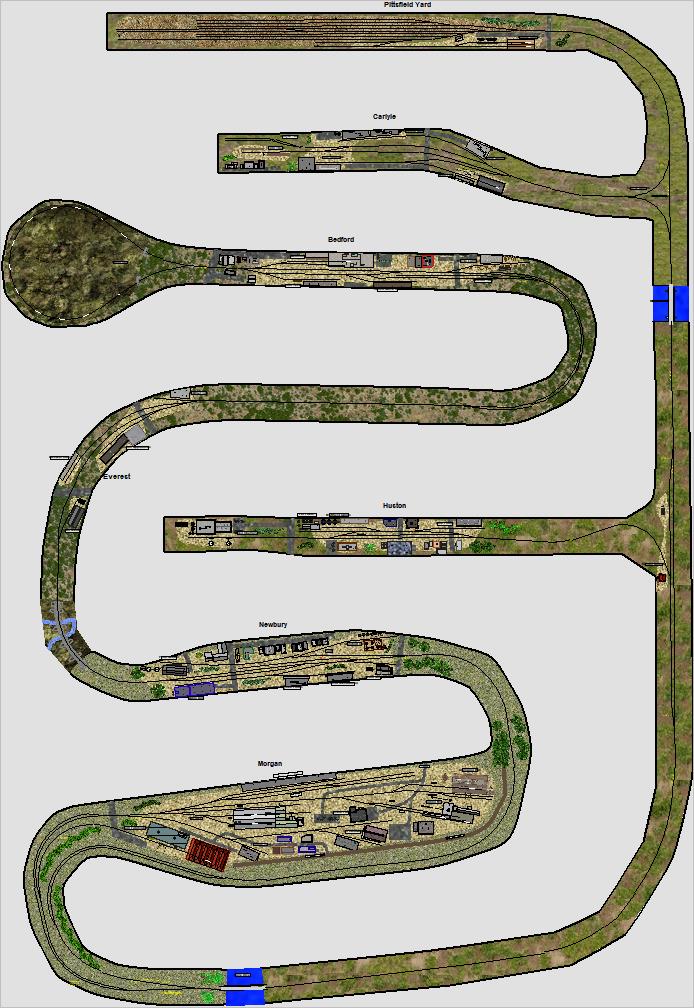 |
| Raritan Central RR | 37 x 111 | The Raritan Central Railway is a short line dedicated to providing seamless and timely transportation solutions for its diverse customer base including warehousing, transloading, packaging, and distribution. Operations are based at the Raritan Center Industrial Park and the Heller Industrial Park in Edison, New Jersey. The locations' infrastructure and strategic positioning enables the Raritan Central to efficiently handle a wide range of materials including paper, plastics, steel, food, dairy, building products, and more. Interchange of cars is handled daily via the CSX & NS connections, allowing shippers access to the entire North American rail network via the Bayonne and Newark Staging Yard. |
 |
| Rock Plain Branch | 22 x 22 | Rock Plain Branch is a 3 ft. narrow gauge railway set in the high plains of Colorado in the 1920s. The Rock Plain Railway is essentially a mining railway. So you will see some sizeable trains running over the rugged hill country to service some local industries along with the two major ore mines and a foundry in the region. There is an interchange with the DRGS at Woody Creek where many cars are exchanged daily. There are two mine /foundry runs - one by the DRG and the other by the Rock Plain Railway[RPR] which operate on alternate days. The RPR also has its Haswell Turn and the Woody Creek Turn which stop at all industries along the route. |
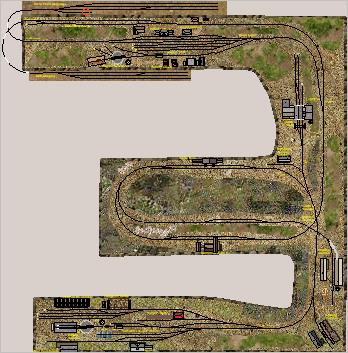 |
| Rodgers Junction Branch | 31 x 81 | This extensively modified layout is directly inspired by a modular FREMO layout which was set up for an exhibition in Rodagau, Germany in 2007. There are 3 large customers on this line: Craven Foods in Cranpool; Big Bear Mines which generates 15-25 loads daily in unit trains; and Fortress Cement which also receives/generates a large number of loads of cement and gravel. Fortress also has its own switcher to shunt cars around their property as needed and to assist the road crews regularly. The unit trains for Big Bear Mines and Fortress Cement originate on the north side of Milton yard. |
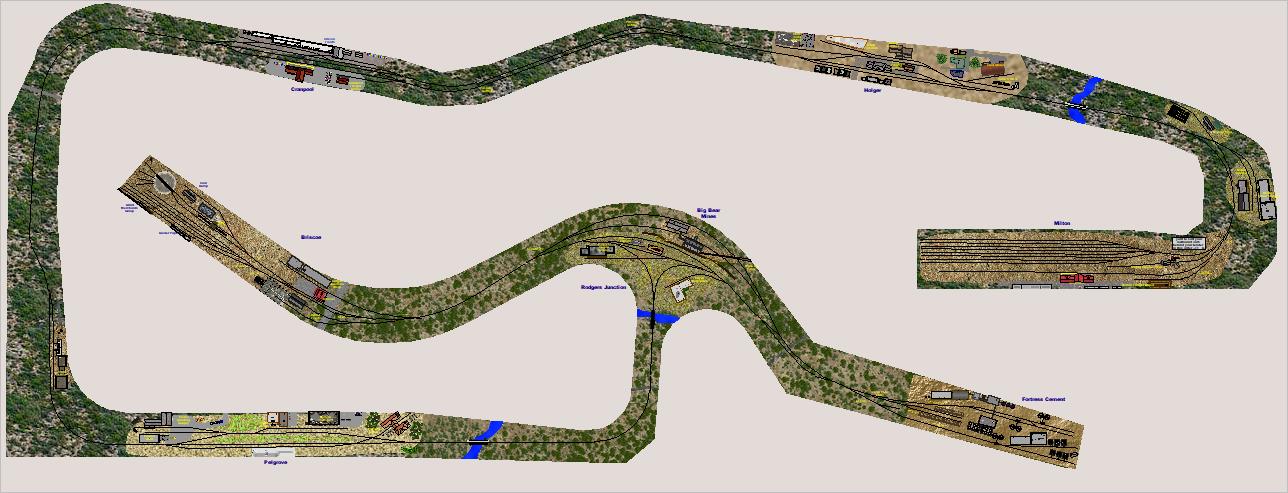 |
| Rutland RR -Mainline Division | 13 x 59 | Based out of Rutland, Vermont, the Rutland Railroad's beginnings date back to 1843. The humble 400-mile long line serviced Vermont and northern New York state up until the early 1960s. This club sized plan covers a portion of the Mainline Division running between Rutland and Burlington Vermont in the early 1930s. The years 1920 to 1937, when the Rutland was under NYC / New Haven RR control, were one of the last great periods of its prosperity. The NYC moved a large amount of bridge traffic over the Rutland to transfer through Ogdensburg which paid for infrastructure and equipment upgrades. The Rutland's primary freight traffic was derived from dairy products, produce, cattle and lumber trade. "The Whippet" was its named high-speed, timed freight train which ran the length of the system hauling bridge traffic between Rutland and the NYC. The Rutland also had an active passenger service with links to Montreal Canada, and New York City. Its best known services were the "Mount Royal" running to Montreal, and the "Green Mountain Flyer" which ran over much of the Rutland's territory with a connection to the NYC. |
 |
| Saddlestring | 19 x 41 | SADDLESTRING is a Division Point on the Wyoming North & South RR, a bridge route between the Union Pacific at Casper and the Northern Pacific in Billings, Montana. To make navigation easier the stations are set out with their names (and codes) in alphabetical order from North to South (N thru to U). There is a schedule of 13 trains running over a two day sequence before the scenario repeats itself (with different outcomes). Engines of all freight trains operating through Saddlestring must visit the Coaling Stage for servicing leaving the set outs and pulls to the Yard Goat. The Goat will sort the incoming cars so they are ready for delivery by the local trains. The Goat will also pull any block of cars intended for the current train's final destination and add that block to the consist. Livestock traffic is handled by the Southbound Stopping Freight and it is important to check the Saddlestring Stock yard for outbound traffic when reassembling that train. A Coal Drag operates from the Northern Pacific's own mines in Montana on alternate days, this train also handles ore shipments from Stinkwater Mine. Empty hoppers are returned on a Northbound train the next day. Passenger trains are only scheduled to stop at Saddlestring, here they must change engines to minimize any delays to their schedule. The Northbound passenger service will add a dining car to its consist and this car will be returned to the Commissary by a Southbound train the next day. Timberline, Quirky and Pronghorn can be treated as flagstops and the passenger trains are permitted to stop at these stations to take on or set down passengers at your own discretion. All yard operations at Saddlestring are handled by the Goat which visits all local industries at least once daily. You will be asked to move the Passenger engine to the coaling stage as part of the daily Yard Job to ensure it can be fully prepared for taking over the passenger train that comes next in the sequence. There are pedler trains operating between Saddlestring and Pronghorn via Quirky, and between Saddlestring and Timberline on alternate days. These trains also switch the local yards and industries at Rimfire Oil and Stinkwater both of which may require local switching of traffic set out by other mainline trains. The Old Stump logging operations at the north end of the layout operates a transfer run between the log camps and the nearby yard at Pronghorn. All routes leading into the Staging loops and Stations will be preset for the active train by Junction Action Scripts but your crew is responsible for setting all the local routes used during car switching operations at Saddlestring and the intermediate locations. |
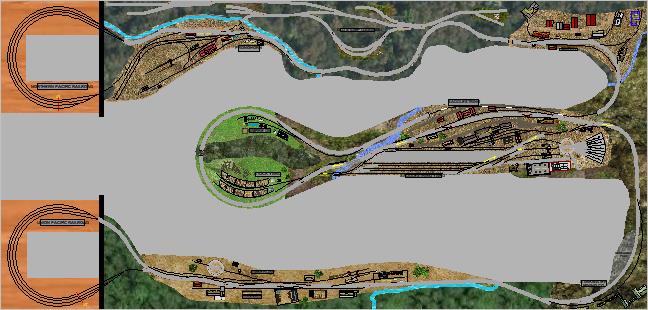 |
San Francisco Belt Line RR |
32 x 44 | The San Francisco Belt Line RR by Gordon Odegard, is a club sized 21 HO scale plan, based on this prototype short line. The time period is the 1930s era. It features "in street" running, lots of switching of wharves and piers and a busy interchange with SF / SP. It originally appeared in 101 More Track Plans for Model Railroaders - Kalmbach Publishing, 2010 - used with permission. |
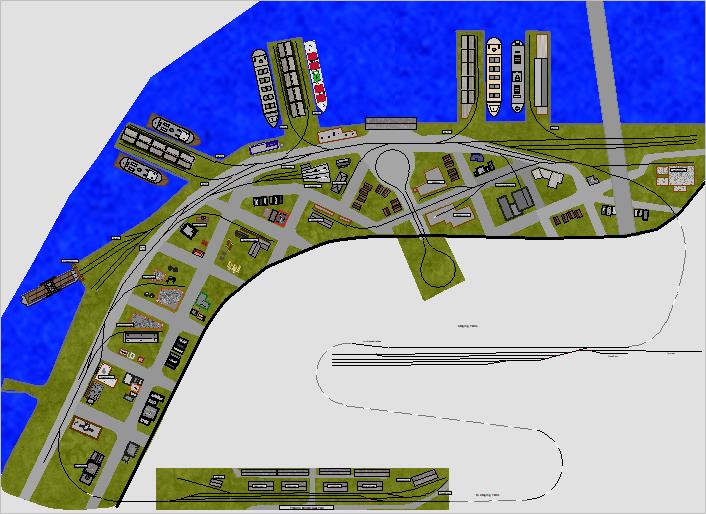 |
Santa Lucia Mtns |
27 x 50 | Bruce Macleod's The Santa Lucia Mtns plan is very condensed representation of the SP line through California's fertile Central Valley, up and over the Tehachapi Mountains and on to LA. This layout depicts the part from the foot of the mountains (Delcamo - in reality is Bakersfield) up the mountains to the high desert area (Indian Wells - in reality Mojave). Delcamo would be a where oil tankers come from producing wells some distance away and then are sent both north and south. The time period is the early 50's to allow for steam and diesel service and this route was freight service only. Operations consisted of several fast freights carrying bridge traffic and/or bulk goods "unit" trains. There are a couple of local peddlers which look after the area's industries. |
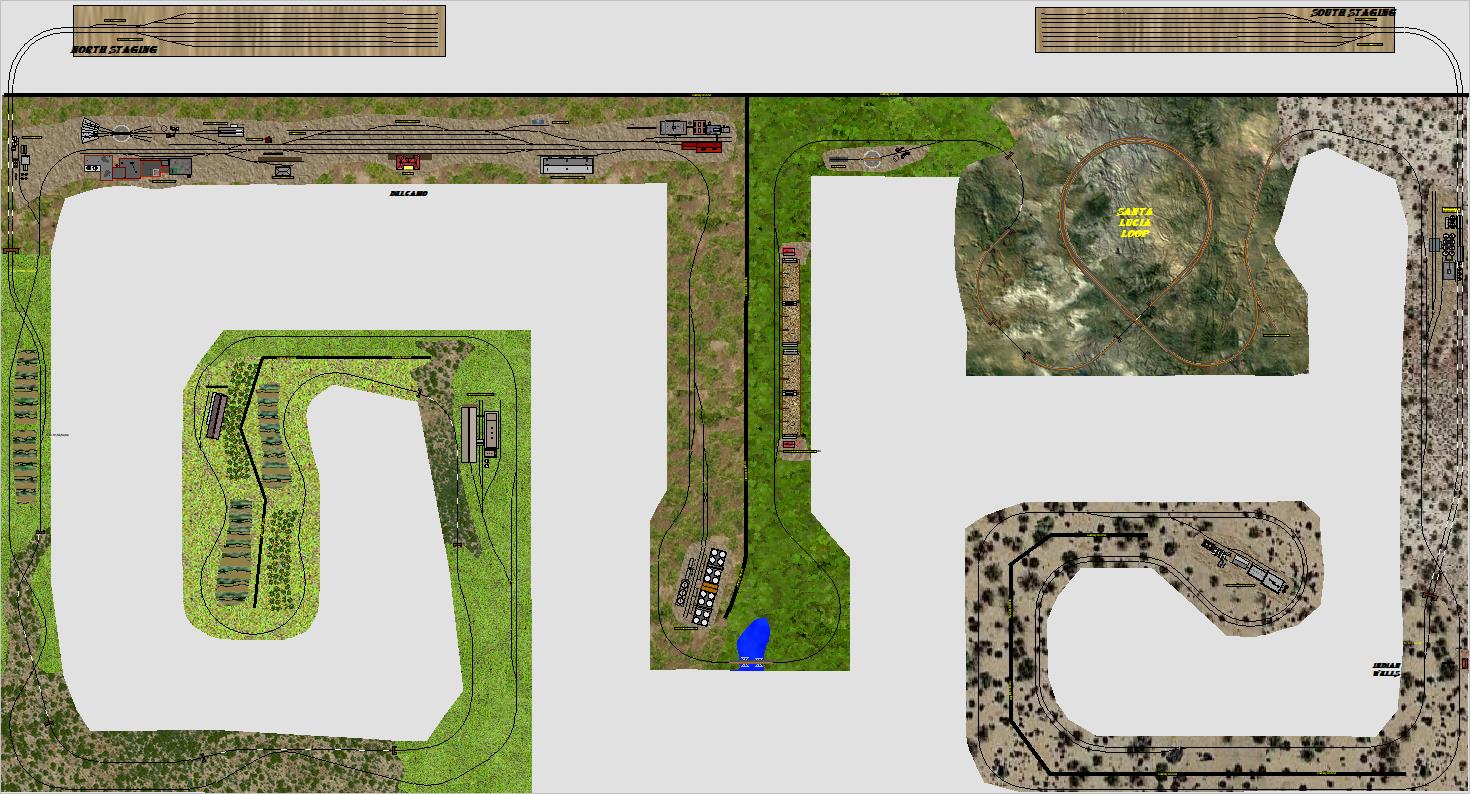 |
Southern Pacific Coast Line |
6 x 69 | The Southern Pacific Coast Line is a fictional representation of the portion of their railway running from San Francisco to the north towards Los Angeles to the south. This imagined line features a number of packing houses, food distributors and processors, grain mills and elevators, an aggregates plant, a cement plant and a good variety of light and medium industries that were still flourishing in the post 1945 era. Passenger services consists of the premium route - the Coast Dayliner through train and for the smaller towns - a gas powered doodlebug stopping at each town. Freight services consist of a transfer/fast freight train in each direction, a reefer express, a hopper special and several smaller local "turn jobs". Steam power is still the mainstay of the SP fleet in this area in the late 1940s. |
 |
| SP San Joaquin Division | 27 x 50 | The San Joaquin Division of the Southern Pacific is set in the late 1940 - early 1950s time period. Steam is still predominant but some small diesels were making their appearance. This part of California is noted for its agricultural output as evidenced by many packing houses along this route. At the same time, there are a few smaller industries, some cattle ranches, wineries, along with freight services provided via Freight Sheds. Much of this division is single tracked with several small centers and so passenger service is still available via a daily "doodlebug". The San Joaquin is broken into 6 zones for operations - Fresno Yard and environs, Exeter, Los Palmas, Clovis, Strathmore & Porterville, and Pinedale & Famoso. |
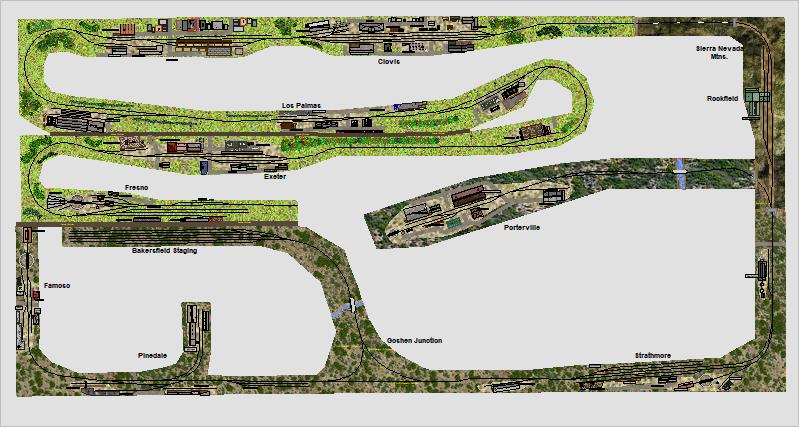 |
| Stratford sub | 16 x 21 | This layout is inspired by several narrow gauge layouts. The main focal point is the C&S Interchange where freight and passenger traffic are exchanged. Any freight cars coming from the C&S are blocked for local customers when they reach Garfield yard. Trains generally run 3 to 4 times per week depending upon seasonal and customer demands. There is little passenger service along the Stratford sub and these needs are met with with the Mixed Train service or the multi-purpose Goose 7. The C&S sends a weekly train along the sub which adds variety and some challenges. |
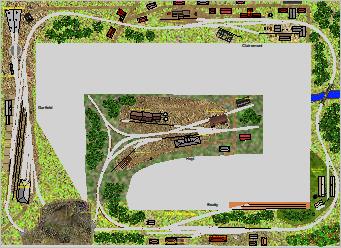 |
The Blueberry Line 1900. |
57 x 131 | The Rice Lake, Dallas and Menomonie Railway (RLD&M) was dubbed the Blueberry Line because of the abundant blueberry bushes that grew alongside the tracks. After extensive logging operations in northern Wisconsin, blueberries thrived on the land. Legend has it that trains on the Blueberry Line would stop so passengers could pick blueberries en route. Likely one train would drop passengers off and another would pick them up. The Railway, which was purchased by the Soo Line Railroad, spanned from Ridgeland, Dallas, Hillsdale, Barron and Cameron to Rice Lake, Campia, Mikana, Birchwood, Edgewater and Reserve. It was projected to extend north to Lake Superior and south to Menomonie but was never completed to those destinations. Over time, the lines were abandoned - the branch line from Birchwood to Reserve in 1931, from Rice Lake to Birchwood in 1936, and from Ridgeland to Barron in 1962. The time period depicted on this plan is the early 1900s when trains were short, passenger service was strong and life was slower paced. |
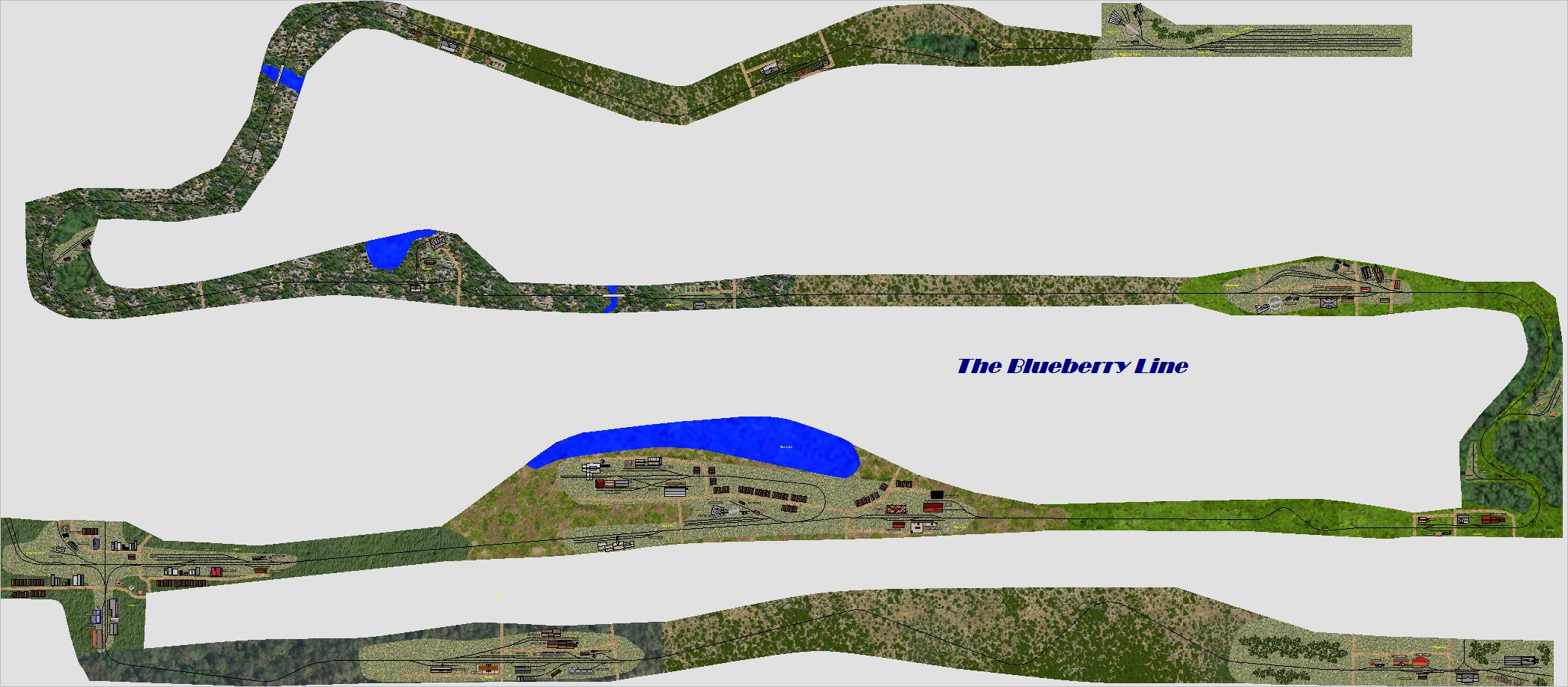 |
| Welbeck Sub | 33 x 34 | The Welbeck Sub is a typical American rail line. It provides transport services to a couple of medium sized coal mines, a small ore mine and a large lumber camp. As well, there are quite a few other resource based industries to serve over this large 3 deck plan. |
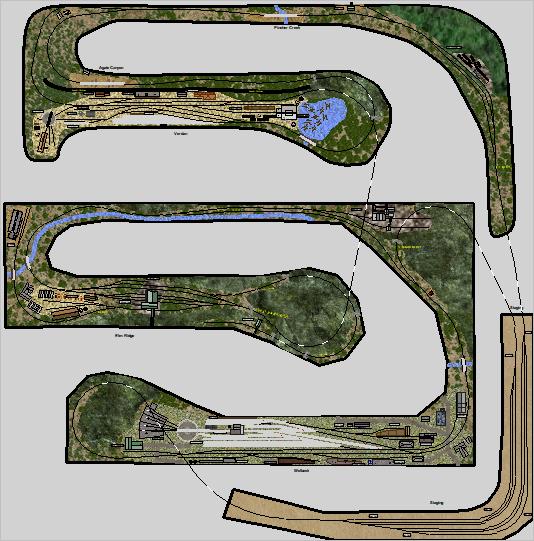 |
West Coast Branch Line |
11 x 107 | This fictional layout is set in Wales. It is an out and back design of an single track branch line running north to south during the 1930s period. The major industries are a coal mine which generates about 20 loads per day and a large brewery. There are also smaller scaled typical industries like livestock docks, goods sheds, dairies, and coal staithes to service along with a mixed group of mid-sized industries. |
 |
| Westport Terminal Railroad | 22 x 31 | Westport Terminal Railroad is a modern day shortline. which bought unprofitable track routes from CN and BN. Under WT operation they have returned to profitability. Average train lengths run from 10 - 12 cars. A couple of Express Freights drop off blocks of cars which are made up at Westport Yard and run through its 4 districts. BN and CN through traffic goes from South Junction to International Falls interchanges with the Staging Yard on this plan representing both interchanges. Freight operations are the mainstay of the WT. It is handled by the road's own engines with help from BN. Some of the commodities are coal, gas, oil, steel, paper, grain, machinery, dairy & meat products and more. Passenger service is provided via a dual RDC 1 and RDC 2 lash up travelling daily through Westport. This HO layout was designed and built by the late Wolfgang Dudler of Schwerte, Germany and you can still find his website here: - http://www.westportterminal.de/wt.html |
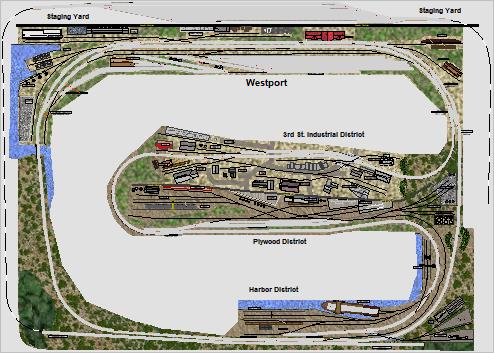 |
| Wilkens Sub | 41 x 59 | This club sized Fremo layout is set in the late steam era. Most rail traffic enters the scene at Wilkens Yard and runs through the sub as far as Jackson Yard. The main traffic sources for the sub are: Red Rock Coal, Gordon Gypsum, Prairie Grain and Ponderosa Cattle. Some careful planning is required since runaround tracks may not be close at hand when needed. |
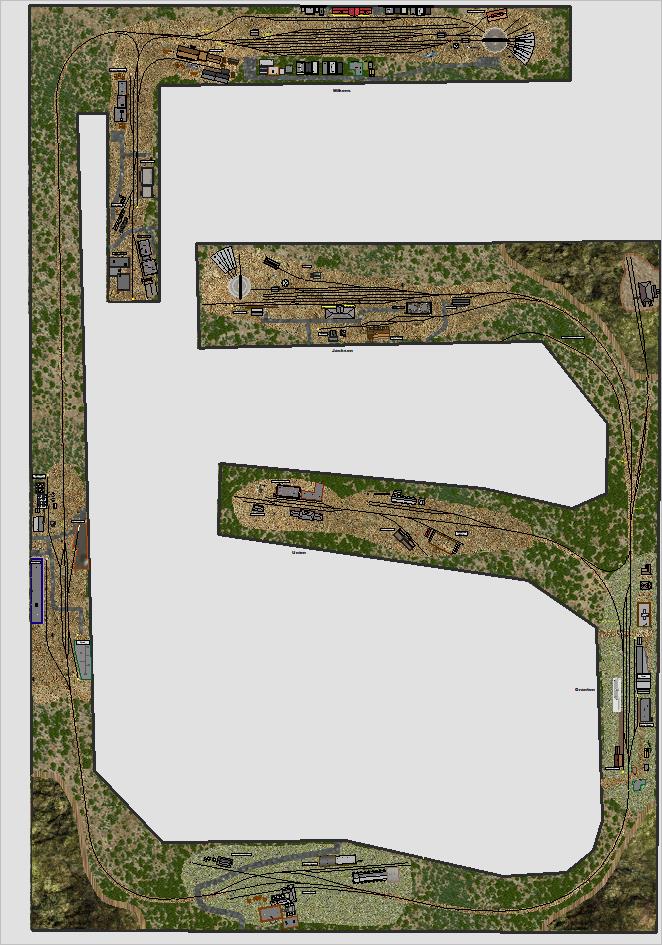 |
| Winston Division | 19 x 48 | Winston Division is a club sized plan which features a good sized Staging yard, a division yard and 2 smaller branch yards. There is plenty of bridge traffic moving between these yards but, there are also some block trains to process daily - serving the coal mine, the grain mill and a couple of smaller sites. Finally in Winston, High Point and Greensboro, there are a variety of medium and light industries which generate regular traffic. |
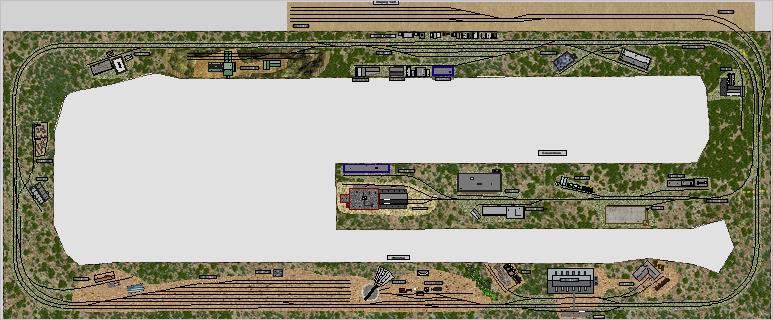 |
| White Pass and Yukon RR 1970 | 22 x 58 | Finished in late 1898, the WP&YR railway was considered an impossible task but it was literally blasted through coastal mountains in only 26 months. The WP&YR climbs almost 3000 feet in just 20 miles and features steep grades of up to 3.9%, cliff-hanging turns of 16 degrees, two tunnels and numerous bridges and a trestle. Although the Klondike Gold Rush faded quickly, the WP&YR became the gateway for tranport of goods to southern Alaska and northern BC and the Yukon. Its primary customers were the various mines in this region. In 1955, the WP&YR built and tested one of the world's first container shipping systems and was the first to enter the integrated ship-train-truck business. By 1969, the modern White Pass customs-sealed containers came in four types - heater, freezer, vented and dry. Containers and heavy deck loads of northbound freight were easily exchanged at Skagway for a southbound containerized cargo of copper, asbestos and silver-lead-zinc concentrate, when mining in the Yukon was at its peak of production. The WP&YR suspended operations in 1982 when Yukon's mining industry collapsed due to low mineral prices. But, the railway was reopened in 1988 as a seasonal and popular tourism operation which continues to this day. |
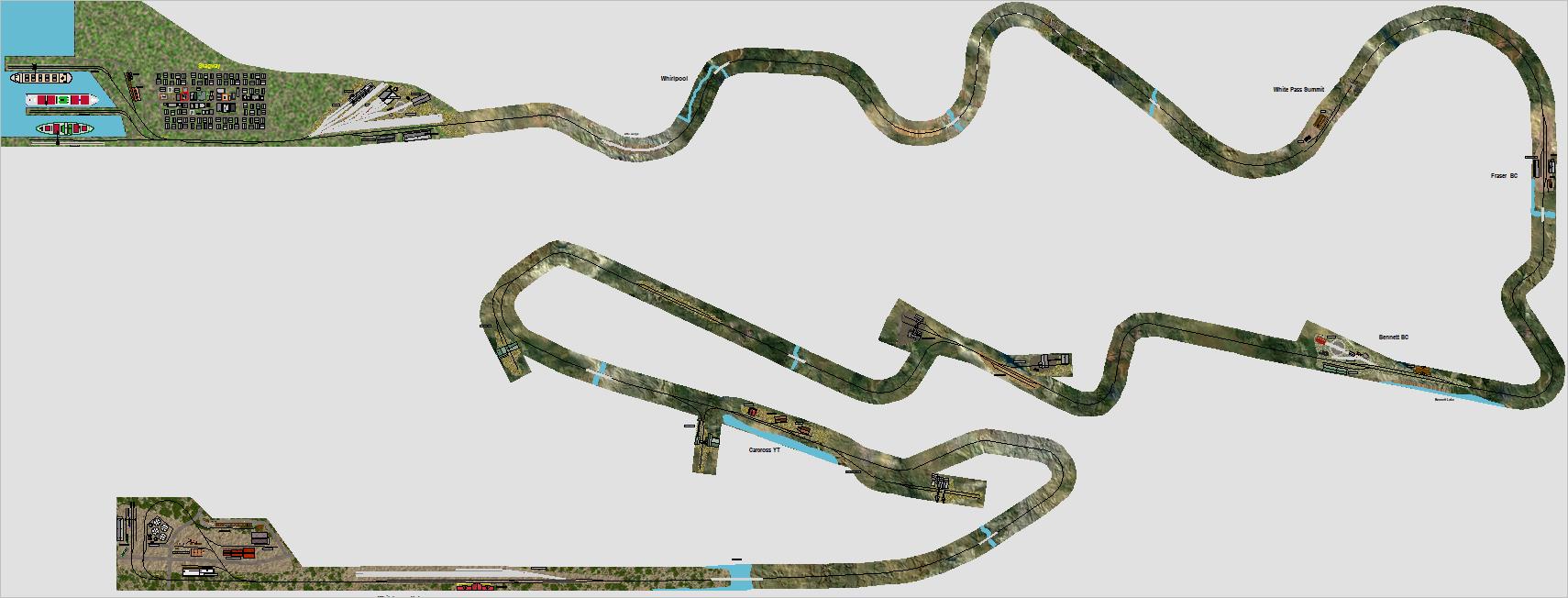 |
| Wescot, Watson and Burns RR | 21 x 37 | The Wescot, Watson and Burns RR [WWB] is a three foot narrow gauge club sized plan. The WWB came to life in the 1890s and its intention was to ship its goods and products to the larger centres to its south. Over its life span, the main goods carried were textiles, milk, cattle, grain, logs and general merchandise with a passenger service between the main 6 towns of Wescot, Whiteman, Winke, Wendy Mills, Watson and Burns. Early in the Great Depression of the 1930s, the WWB fell on hard times and ceased all operations. The WWB was a prime hauler of high quality slate used for roof tiles, pottery and landscaping. The Quarry train runs daily while the other trains run on alternate days. As well, the local timber camp ships its logs to an offsite sawmill for processing and forwarding to the larger cities to meet their construction demands. |
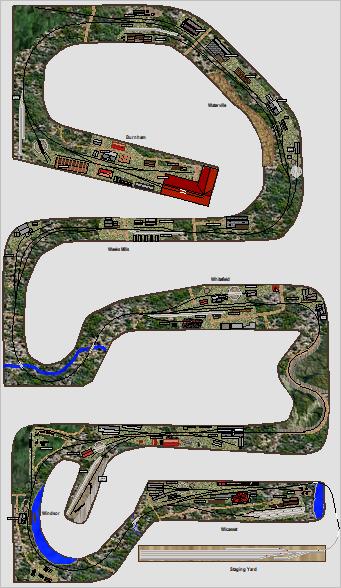 |
The Wiscasset, Waterville and Farmington Railway |
13 x 201 | The 'Wiscasset, Waterville and Farmington Railroad' originally opened as the 'Wiscasset and Quebec Railroad' in 1895. This was a 2 foot narrow gauge railroad which linked the Maine towns of Wiscasset and Albion, a distance of approximately 43 miles. Operations between Wiscasset and Weeks Mills (28 miles) started in February 1895 and track laying quickly reached the town of Burnham (54 miles from Wiscasset). Unfortunately the plan to continue the line through northern Maine into Canada failed because of an inability to negotiate a crossing of the Belfast and Moosehead Lake Railroad near Burnham Junction. The reorganized 'Wiscasset, Waterville and Farmington Railroad' then lifted the 11 miles of unused track between Albion and Burnham, and built a new 15 mile branch line from Weeks Mills through to the Kennebec River at Winslow. A new company, the 'Franklin, Somerset and Kennebec Railway' was chartered in 1897 with the aim of extending the new branch to connect with the extensive 2 foot gauge Sandy River system at Farmington. Construction on the northern section between Farmington and New Sharon began in 1901 but the work was never completed because the Maine Central Railroad objected to a connection between the two narrow gauge lines on Maine Central owned land in Farmington. The existing 15 mile branch to Winslow operated as the main line from 1902 to 1916 when it was abandoned because of falling revenues. In its heyday the 'Wiscasset, Waterville and Farmington' hauled potatoes, lumber, and poultry along with other general freight and passengers. Freight tonnage in 1914 was 43% outbound lumber, 16% outbound potatoes and canned corn, 14% inbound feed and grain, 10% inbound manufactured goods, 5% inbound coal, and 4% outbound hay. By the late 1920's, the railroad was struggling against road transport competition. It was bought by a local businessman with lumber interests in Palermo and renamed as the 'Wiscasset, Waterville and Farmington Railway'. The new owner also purchased two cargo schooners to bring in coal from Boston and return south with lumber, with the railroad transporting the coal and lumber between Wiscasset and the Maine interior. On June 15, 1933 operations ceased following a locomotive derailment and the line was finally abandoned in 1936 following the death of the owner. Most of the railroad was scrapped and the schooners were left abandoned beside the railroad wharf in Wiscasset. |
 |